Your Step-by-Step Guide to Making the Perfect Resume (With Examples!)

Your resume is arguably the most valuable piece of paper for your career. But this document can be daunting for many. Maybe you’re not sure how to fit in all your information onto one page. Maybe you’re not sure about the right way to format and write your resume. Maybe you don’t even know what the heck a resume is!
Whatever your concern, we’ll break down everything you need to know about making the perfect resume, from scratch.

What Is a Resume?
What are employers looking for in a resume.
- Pick Your Format
- Start With Your Basic Information
- Add in Your Work Experience
- Consider Including Volunteer Work or Other Experience
- Don’t Forget Your Education
- Top It Off With Some Skills and Interests
- Write a Resume Summary Statement (if Relevant)
- Tailor It to the Job (and the ATS)
- Edit and Refine It
What Are Some Examples of a Good Resume?
A resume is a summary of your career, whether yours is just getting started or has been going on for years. Coming in at around one page in length (two only under specific circumstances), it showcases the jobs you’ve held and currently hold, the responsibilities you’ve taken on, the skills you’ve developed, and the qualities you bring to the table as an employee. Together, those things make it super easy for any hiring manager to see your qualifications and fit for a role.
For all the work you may put into writing one, hiring managers actually spend very little time—mere seconds in many cases—looking at your resume. But despite this sad fact, it’s safe to say that creating a great resume (rather than hastily throwing one together) still matters.
“If you miss the mark, your resume may never be read. Even worse, you might be removed from the applicant pool by a computer before a human even knows you exist,” says Muse career coach Heather Yurovsky , founder of Shatter & Shine. So you want to get it right because, as she explains, isn’t the goal to “spend less time looking for a job and more time in a role you love?”
You might be wondering if you can lean on your LinkedIn profile instead of writing a resume. The answer, sadly, is no. Most hiring managers still expect you to submit a resume, even if they also look at your LinkedIn. Even if you don’t need a resume for a job you’re applying for now, you’re going to need one at some point in your career—they’re not anywhere close to going out of style. So it’s best to always have one at the ready should an opportunity pop up.
And although LinkedIn has plenty of benefits, a resume has one clear advantage: While your LinkedIn is usually a broader picture of your career trajectory, your resume gives you the opportunity to tailor your career story to a specific role or company (more on that later).
Oh, and you’ve probably heard of something called a CV? It’s slightly different from a resume , and usually more common with academics and job seekers outside the U.S.
Hiring managers look for three things on your resume, “What did you do? Why did you do it? And what was the result?” says Muse career coach Martin McGovern , owner of Career Therapy. “If you can answer all three of these questions in...your resume bullet points, you’re going to be on the right track.”
Clear, easy-to-understand language is key. “The truth is that most resumes make no sense. They are stuffed with jargon, they are too technical, and they are filled with redundancies. Try to read a resume that isn’t yours and you will quickly realize that it feels like an alien wrote it,” McGovern adds. Put yourself in the shoes of a recruiter who has no idea how your role works—how can you make your resume accessible to them?
The hiring manager also cares about more than just you and you alone—they care about you in relation to them. “Hiring managers want to see if a candidate matches the requirements” of the role they’re hiring for, Yurovsky explains. “Your resume should paint this picture so the hiring manager not only knows what day-to-day responsibilities you can handle, but why you, above other[s], bring value to their organization.”
How Do You Write a Resume?
Whether you’re someone who’s never written a resume in your life, or you need a nice, thorough refresher on the process of creating one, follow these steps to go from a blank page to a complete—and dare I say beautiful—document.
Related: This Free Worksheet Makes It Easy to Create (or Update) Your Resume
1. Pick Your Format
Before you start typing one single thing, you have to decide what you want the overall resume to look like.
Resume builders can be helpful for this step—they’ll take all your basic information and organize it for you, eliminating some of the legwork. You can also use a pre-made outline, such as one of these free Google Docs templates .
But it’s often safest to start with a clean slate all on your own and eventually upgrade to a more advanced layout. (If you'd still like a place to write all the relevant information before you get started, check out our resume outline .) This allows you to course correct, edit and re-edit, and choose a resume format that best fits your particular situation (after all, not everyone has a career trajectory that’s easy to compartmentalize).
In general, you’re most likely to cover and/or include sections on the following:
- Your work experience
- Your non-work experience, including professional organizations, community involvement, or side projects
- Your education and certifications
- Your skills (specifically hard skills) and interests
So how do you format and organize all of that information?
By far the most common (and safest, if you’re not sure which route to take) option is reverse chronological order . This means you organize your experiences from most recent to least recent. So your work experiences would go above your education, and your current role would go above previous roles you’ve held. This of course has its exceptions—maybe you went back to grad school between jobs, or your most recent role is irrelevant to the job you’re applying for. So the whole page may not be exactly in reverse chronological order depending on your situation. It’s just a guideline.
There’s also something called a functional or skills-based resume . This is used pretty rarely, mainly with career changers and those with limited or complicated work histories. It gets its name because it’s primarily about listing your skills rather than experiences, and showcases them above your work history and education.
You can also opt for a combination resume , which is a mix between a reverse chronological resume and skills-based resume. It highlights your skills at the top, but allows just as much room below to cover your job and school experience.
Use caution when choosing these two formats: “Combo and skills-based [resumes] can be hard to follow, because [they force] the reader to hunt for connections between your skills and experience, and [don’t] provide the full context of your work,” says Muse Career Coach Angela Smith , founder of Loft Consulting. “I’ve also heard a lot of recruiters say that they automatically discount skill-based resumes because they feel the candidate is trying to hide something. I don’t necessarily believe that, but I think it’s important for job-seekers to know that perception is out there.”
2. Start With Your Basic Information
Your contact information should always go at the top of your resume. In this header you’ll want to include anything that could be helpful for a recruiter to get in touch with you. Usually, this means adding in:
- Your full name (preferably the name you use across the web)
- Your phone number
- Your personal email address
You might also choose to include other basic information, such as your LinkedIn or personal website URL, your GitHub (for technical roles), your social media profiles (if relevant to the job), or your address. If you’re looking to move for a job, you may choose to leave out your address or write “open to relocating” to better your chances of getting an interview.
The key is to make this part as clear as possible. If a hiring manager can’t reach you, there’s no point in perfecting the rest of your resume.
3. Add in Your Work Experience
This section will most likely be the bulk of your resume. Even if you’re changing careers, employers still want to see where you’ve worked, what you’ve done, and the impact of that work to get a sense of your background and expertise.
Your “Work Experience” might be one entire category, or you might choose to break it up into “Relevant Experience” and “Additional Experience” to highlight the jobs that are most important for hiring managers to focus on. Either way, you’ll almost always want to have your most recent experience at the top and your older experience down below.
Within your work experience, you’ll want to include each official job title, the company (and possibly its location), and the years you worked there. Below that, you’ll add in two to four bullet points explaining what you did in that job, the skills you built and exercised, the tools you used, and the results of what you did. If you accomplished a lot during your time there, focus on the responsibilities that made the most impact or you’re the most proud of, as well as the ones that best align you with the job you’re applying for (more on that in the following sections). It’s key here to list, if relevant, quantitative as well as qualitative accomplishments.
For example, you might write:
Associate Accountant, Finances and Co., Ann Arbor, MI September 2017 – Present
- Manage billing and invoicing for more than 50 clients, ensuring the deadlines and needs of our enterprise partners, including Big Company and Super Star Org, are met
- Collaborate closely with sales, account management, and project management teams on project setup, maintenance, and invoice management
- Assist in the streamlining of invoicing guidelines and procedures through documentation and the implementation of new software, resulting in an average two-week decrease in total time spent per client
Your resume bullets should be in past tense if you’re referring to past jobs and present tense if you’re talking about your current roles. In addition, your bullets should always start with a strong action verb that best describes what you did. And if you have examples of your work, consider hyperlinking them here as well.
If you have a ton of experience and this category is starting to run long (read: over one page), consider kicking out your oldest jobs unless they’re super relevant to the job you’re applying for, or extra impressive for your field.
Not sure where to start? “It’s helpful to do a brain dump and create a document that has everything and anything you consider as experience or an achievement,” says Yurovsky. From there, she explains, you can start to whittle down what is and isn’t important. And you can refer to this document later if you ever decide to update your resume for a specific role.
Need more specific advice on listing your work experience on your resume? Check out these additional resources:
- When you’ve held multiple jobs at the same company: 2 Jobs, 1 Company: How to Show Multiple Positions on Your Resume
- When you’re not sure what your accomplishments are or how to explain them: Resume Revamp: How to Turn Your Duties Into Accomplishments
- When you want to spruce up a boring or insignificant job: How to Make Your Most Boring Jobs Sound More Interesting on Your Resume
- When you’re considering fudging a job title: The Answer to “Can I Change My Job Title on My Resume to Make It More Accurate?”
- When you’ve had a bunch of short-term gigs: How to List Temporary Jobs on Your Resume
4. Consider Including Volunteer Work or Other Experience
Anything you’ve done that’s not work experience—your side gig, volunteer work, special projects—can be hosted under clearly-labeled sections (“Volunteer Experience” or “Activities,” for example). Depending on how robust your work experience is, these things may be worth including, particularly if they’ve helped you level up your skill set or better align you with your dream job. Plus, they make you look that much more well-rounded, passionate, and hardworking.
If you’re a recent grad, you might also build out a section for on-campus activities, such as clubs, organizations, or leadership experience. This can be a great supplement if you’re lacking in the jobs department. You can frame these just as you would professional jobs—including your title, the organization’s name, and bullets describing what your role was and what you accomplished.
Read More: This Is Exactly How to List Volunteer Work on Your Resume
5. Don’t Forget Your Education
If you’re still in school or just graduated, your education can go at the top of your resume, but for pretty much everyone else, this goes near the bottom. Most people include their school, graduation year (for folks less up to about a decade out of school), major, and degree. Brand-new grads might also write in their GPA, honors and awards, study abroad, thesis, or other notable achievements. But keep this section super simple, as you don’t want it to take up too much space over your work experience.
It’s possible you have unique education experience, such as taking an online course or certification. If you did this specifically as a way to boost yourself within your industry, definitely include it. Again, list everything more or less reverse chronologically—so a grad school degree would go above an undergrad degree, and a more recent relevant online course would go above that.
Learn more about the ins and outs of listing your education on your resume:
- How to (and How Not to) List Education on Your Resume
- How to List Online Courses on Your Resume the Right Way (Because Yes, There Is a Wrong Way)
6. Top It Off With Some Skills and Interests
The skills section of a resume gets a bad rap, but it’s just as important as the rest of the stuff you include. It’s a quick list a recruiter can scan to see if your skill set aligns with what they’re hiring for. And it’s super ATS-friendly (ATS stands for “applicant tracking system,” the robot that in some cases reads your resume before a human does) because it allows you to add in keywords the machine is scanning for.
Usually this section goes at the bottom of your resume, but in special cases—such as a skills-based resume or when someone’s switching fields—you may place it further up.
What exactly do you throw in here? You’ll want to list any hard skills and applications you’re familiar with (Photoshop, SEO, JavaScript, to name a few examples), and, if relevant, your level of expertise. Avoid including soft skills here, like time management or public speaking—save those for your bullet points instead.
Be strategic when filling in your skills. Don’t list things you actually couldn’t do at a high competence level (I’m looking at those of you who say you’re “great” at Excel), and maybe nix skills that are completely irrelevant to the job you want. For example, you may not even need to include Excel if you’re applying for say, a design position, unless it’s listed as a job requirement.
Maybe you’re thinking, I’m a really good volleyball player, but that’s not a “skill,” right? No, it’s not, but it is a hobby. Adding in a hobby section at the bottom of your resume is underrated, and frequently a smart choice. It can be a great conversation starter with a hiring manager, and it can show that you’re a good culture fit—or a culture add—for the company. Also, it’s just a nice way to add in some of your personality. So tack on a bullet point listing out some of your interests, such as hiking, rowing, or crafting (no more than five to seven work-appropriate verbs), and you’re all set here.
7. Write a Resume Summary Statement (if Relevant)
You may have heard of a resume summary statement . They’re not super common, but they can be useful to include near the top of your resume if you’re looking to add clarity or context to your resume. If you’re a career changer, you might find a summary statement helpful in explaining your leap and tying your experience to your new path. Or if you’re a more experienced professional, you can use a summary statement to highlight a theme that brings your career trajectory together.
Overall, you probably won’t need a summary statement if your career is pretty linear and your bullet points do a great job of emphasizing what you have to offer in terms of skills and experience. But if you think it makes sense to include one, “Take the time to think about what the person reading your summary wants to know before you write it,” says McGovern. “Good summaries explain why you do what you do and how it can help. For instance: Merging a background in ABC, I help companies improve XYZ through 123. Summaries shouldn’t be any more complicated than that.”
So, taking McGovern’s example, you might say:
Merging a background in social media marketing and PR with seven years in the consumer tech space, I help companies improve their internal and external communication and brand awareness through data-driven, quality content and strategies that align with the modern trends of the space.
Yurovsky adds that “you don’t want your summary statement to be a dense paragraph with too much information. You want it to be easy to read, concise, and memorable. Almost like a tagline.”
Read More: 3 Resume Summary Examples That’ll Make Writing Your Own Easier
8. Tailor It to the Job (and the ATS)
Once you have your resume written out—you’ve broken down your work experience, tagged on some activities and additional experiences, and listed out your skills—it’s important to go back to the job description (or multiple job descriptions, if you’re applying to several similar jobs) and make sure that what your resume says matches up with the kind of candidate the employers are looking for. In other words, tailor it .
Let’s explain further. You’ll want to begin by tackling the ATS . This means combing the job description to see if individual words and phrases line up. What skills are they asking for, and have you listed them (so long as you actually have them)? What words are they using to describe their ideal hire, and do you use similar language in your resume?
Next, take a bird’s-eye view. If you were the hiring manager for the role, where on your resume would your eyes be drawn to? And what would you be looking for? Whatever you think will be most important for the recruiter, make sure it’s near the top of your resume, or otherwise emphasized.
Finally, dig into the role and responsibilities of the job. Does your resume reflect similar experience? If not, is there a way you can spin it so that it’s clear you’re capable of doing the job (and doing it well)?
These articles can help you if the word “tailoring” makes you start to sweat:
- What It Really Means to “Tailor Your Resume”
- Your Guide to Making Unrelated Experience Look Relevant on Your Resume
- A Cool Trick: How to Spin 1 Resume Bullet 5 Different Ways
9. Edit and Refine It
Please, please don’t just write your resume and shoot it out without giving it a second glance. Hiring managers may not spend hours browsing it, but if there’s one thing that sticks out more than anything else it’s a glaring typo.
The best approach? Write a rough draft, then leave and come back to it later with fresh eyes to give it an edit.
Cover the basics: Is your contact information correct and updated? Are you using the right verb tenses? Does everything look consistent and accurate in terms of spelling and grammar?
Then do some cutting if your resume’s quite long. It’s no longer a hard-and-fast rule that all resumes must be only one page—but consider it a smart guideline for most applicants, especially if you've got less than 10 years work experience. The exception is if you’re very senior or very established in your career; in this scenario, a two-page resume isn’t completely out of the question. Everyone else, read this article for advice on how to cut your resume down.
Formatting-wise, it’s key to consider a couple things. First, what font are you using , and is it legible (for a human and a robot)? When in doubt, go with one of these simple, but sleek, options: Arial, Arial Narrow, Calibri, Cambria, Garamond, or Helvetica.
Second, are you going to save it as a Word document or PDF ? Neither option is wrong, although a PDF helps ensure that your formatting is maintained, no matter what type of computer the hiring manager uses to open the document.
Third, is your resume formatted in a way that it’s skimmable? If it’s feeling crowded or overrun with words, read this: 12 Tiny Changes That Make Your Resume Easy for Recruiters to Skim .
Once you’ve given it a few good looks, it may be worth sending it to a friend or colleague (or even a career coach ) to get a second opinion. Don’t just have them edit it for spelling and grammar—they should dig into your bullets and offer feedback on whether or not your resume is showing you in the best possible light (it’s smart to also send them the job description for something to compare it to).
Here’s the thing: Your resume won’t ever look exactly like someone else’s, nor should it. How you choose to format it, organize your information, and talk about specific experiences depends not just on your career path, but on your field, the job you’re applying for, the company that job is at, and more.
So there isn’t a universal way to do a resume. But there are common themes. To give you some context as to how yours might turn out, here are three examples of different kinds of resumes.
The Most Popular: A Reverse Chronological Resume
As previously mentioned, a reverse chronological resume is preferred by many coaches and HR experts, mainly because it’s super readable. When everything’s in a clear order, it’s easy to skim and even easier to draw lines between experiences.
Who it’s good for: Just about everyone—from students applying to internships all the way up to senior-level executives (with an optional resume summary statement)
Download an Example Chronological Resume for a Software Engineer
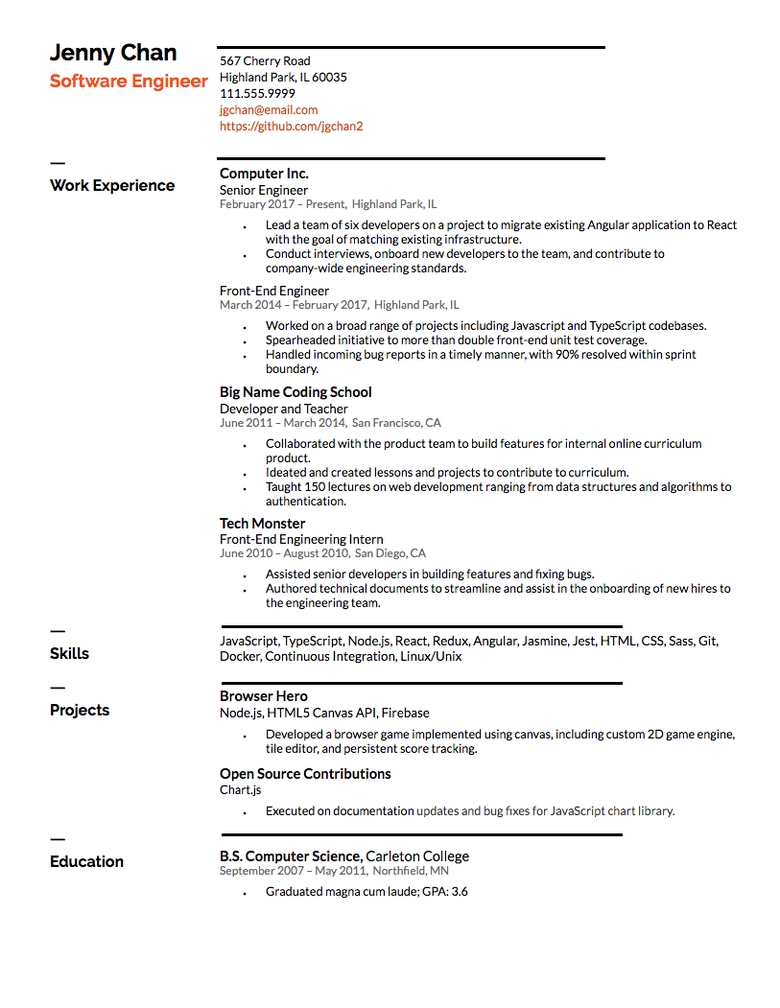
The Unorthodox Route: A Functional or Skills-Based Resume
Rather than listing out your experience in reverse chronological order, a functional or skills-based resume has bullet points that reflect how each of your skills is demonstrated by the work you’ve done over the course of your career. At the bottom, you’ll include everything else, such as your education, job history, professional achievements, community involvement, and other technical skills. This is a good option if you have a somewhat all-over-the-place work history and want to tie everything together neatly.
Who it’s good for: Career changers whose work experiences may not appear to be relevant and people with an abundance of temporary jobs or gaps in their work histories.
Download an Example Functional Resume for a Project Manager
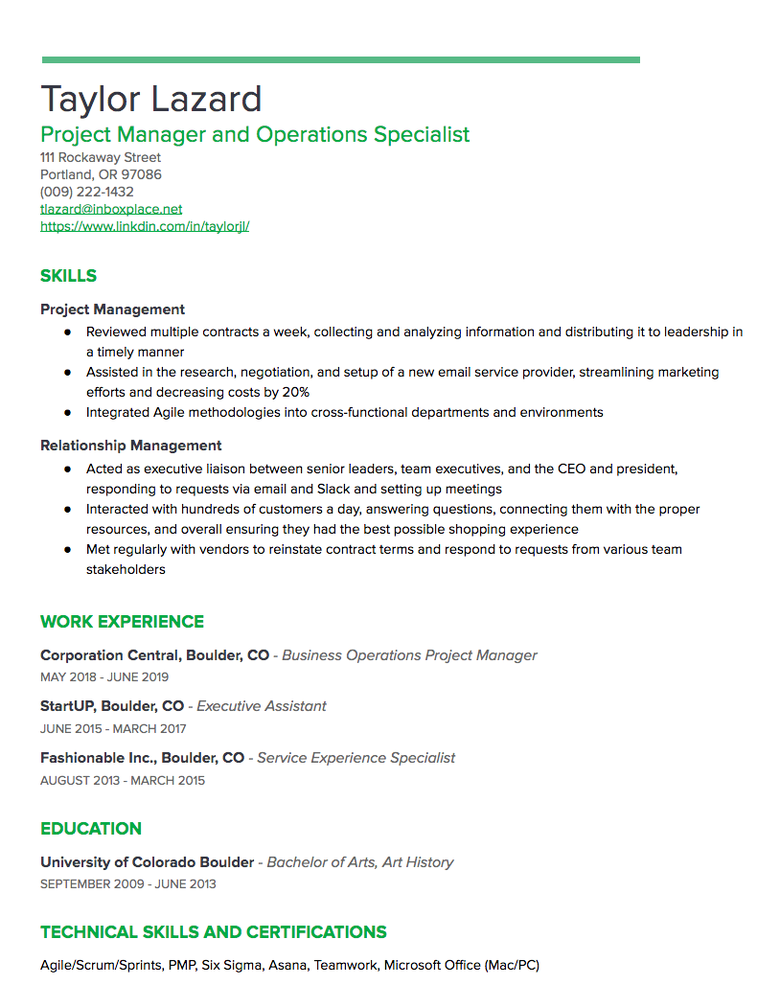
The Creative Angle: An Infographic Resume or Resume Website
This resume type is characterized by how it’s formatted visually. You may choose a reverse chronological order or skills-based style to organize your information, but also use graphics, colors, unique fonts, and even multimedia elements to help that information pop. Keep in mind that any creative resume is still likely subject to an ATS—and certain elements may be unreadable by a robot. So consider going this route only if you know a human will be reading your resume (and that said human might enjoy it).
Who it’s good for: People applying to creative roles (designers, editors, writers, marketers, video producers, for example), startups, or fun companies, or to jobs where a creative resume is encouraged, if not required.
Download an Example Infographic Resume for a Designer
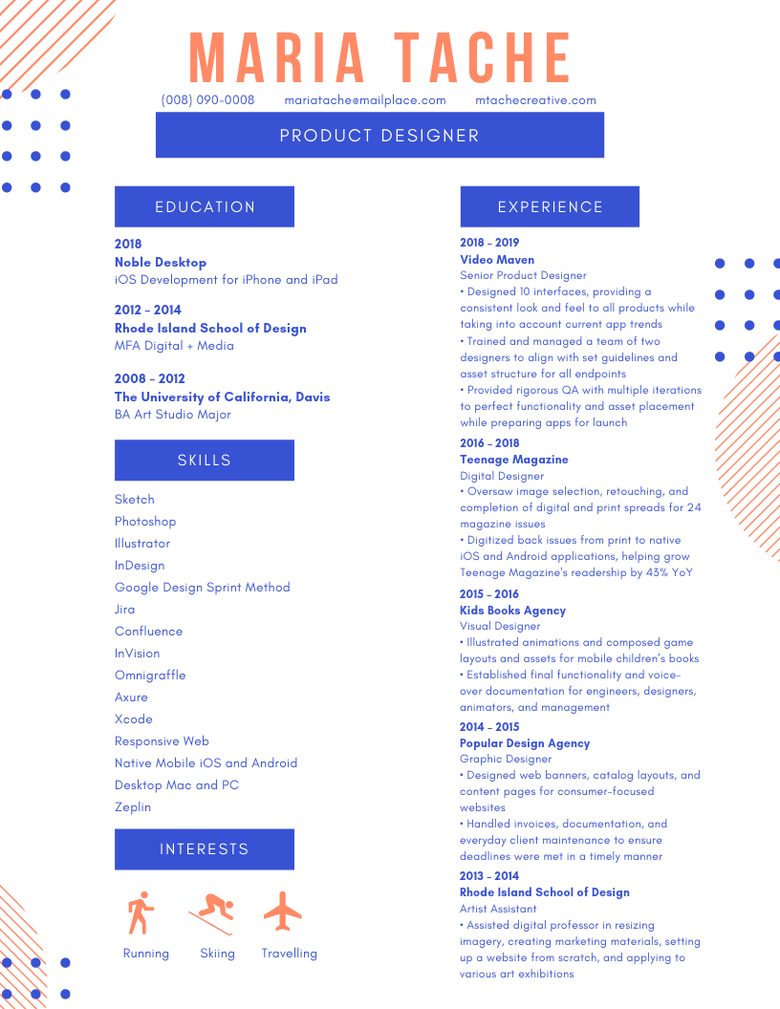
Not a designer but want your resume to look just as pretty as this example? Check out these articles:
- 5 Sites to Create an Awesome Infographic Resume (Even if You’re the Least Creative Person Ever)
- How to Build a Resume Website That Will Impress Every Hiring Manager Who Sees It
- 5 Digital Tools That Will Make Your Resume Infinitely More Beautiful
Your resume is a living, breathing document. So while you won’t go through this whole process every time you apply for a job, you should be thinking about all these things as you go to update your resume for your next career step. You might decide later on to switch up the order, or remove or add things, or even get creative and try out a whole new format. If you’re not getting the calls back you expect, you may decide to scrap it and start over —and that’s totally OK.
Regardless of where this piece of paper goes and how it grows, when you give it the care and attention it deserves, you set yourself up for success. And you’ll make it that much more likely that you’ll land an interview and get the chance to prove to the hiring manager—over the phone or in person—what you’ve got to offer.

Resume Writing Tip: How to Perfectly Describe Your Work Experience
What is “work experience”.
The work experience section of your resume provides employers with an overview of all jobs you’ve held in the past. Whether you’re brand new to the workforce or making a career change, it is the first thing you need prepared and ready to go.
A well-written work experience gives your resume a major credibility boost that can determine if you’re a perfect fit for a role.
Your work experience should highlight…
- The companies you worked for
- The positions you held
- Dates of employment
- Brief descriptions of your responsibilities
- Key achievements
Read on to find out how to showcase your experience in the best way!

How to make your job history more appealing
Begin by listing your most recent experience, followed by your more previous ones. Rather than cramming this section full of buzzwords and standard responsibilities, focus on result-oriented accomplishments instead.
Some common guidelines to follow are:
1. Use bullet points
Briefly describe the scope of your responsibilities for each job in no more than three sentences.
2. Be specific about what you accomplished
Stating numbers, facts, and figures explains your contributions and achievements better.
3. Begin with action-benefit statements
Stand out by using action verbs that emphasize everything that makes you the best candidate for the job.
So instead of describing yourself as “ A result-driven individual with 3 years of experience as a Team Lead”, you’re more likely to leave a strong impression with this: “Managed a team of over 30 employees in Customer Service.”
The latter example explains your leadership experience better than stating the amount of time you spent doing it.
4. Include your key achievements
Highlight information that details your best accomplishments and learnings – something your prospective employers cannot miss.
Work Experience Examples:
Design Team Lead, Hiredly
March 2020 – Current
- Develop original concepts and sketches of new designs
- Lead the design, development, and execution of branding projects
- Review and edit social media visuals using Photoshop or Illustrator
- Supervise and direct the design team in content creation for advertisements and printed materials
- Awarded Employee of the Year twice in a row (2020 – 2021)
Junior Graphic Designer, ABC Company
June 2018 – February 2020
- Pitched creative ideas and project timelines to management
- Produced prototypes and engaging design solutions like logos, banners, and interfaces
- Communicated with clients to go over their needs and desired outcomes
- Performed other tasks related to graphic design such as designing web pages as per client specifications
How do you write about work experience with no work experience?

You might have less than 1 year of work experience or none at all. In this case, especially when you’re entering the job market for the first time, you’ll want to emphasize other experiences that helped you in your career journey . Give your skills as much prominence as possible.
The key is making sure your resume is tailored to the job you are applying for so that a hiring manager can see how you would benefit the company.
Check out the article below to see examples of other experiences you can include in your resume:
- How to Write About Your Educational Background
- How to Write About Your Extracurricular Involvement
- How to Write About Your Projects
Related: How To Ace A Job Interview With No Work Experience (With Sample Answers!)
Build a professional resume in seconds.
Sign up for an account on Hiredly and you’ll get to create a professional and customisable resume recruiters love! It also gives you more accurate job recommendations on Hiredly.
Free to download and share anywhere you want. Try our Resume Builder today !
Check out other helpful resume-writing tips here:
- Picture Perfect: Resume Photo Do’s & Don’ts
- Write a Standout Personal Summary for Your Resume (With Examples)
- 5 Resume Tricks Recruiters Will Thank You For Using

American Society for Microbiology
How to build your experiences towards a resume.
March 15, 2019
A good resume needs to show that you already have the skills needed to be successful in a target job. A resume needs a lot of planning, regular input from experts and flexibility on your part. The most important step to building a strong resume is to start early. We explain how to successfully build resumes at various stages of your career.
As an Undergrad, Focus on Grades and Internships
In your early years, it’s normal to not have a clear idea about the job you want. However, you need to show proficiency in science and math by picking relevant courses and getting strong grades. Also, you need to start thinking about how you will show essential non-technical skills to be a successful scientist. These include effective communication and the ability to work well with others. Fortunately, most undergraduate universities provide a great place to build these skills. Participation in Greek organizations, intramural sports, or other group activities can help show that you have the skills needed for a job but also personality. For example, being active in a club requires you to regularly work with club members and report to university leadership. Starting a fraternity food drive to benefit a local charity shows creativity, initiative, leadership, the ability to coordinate groups of people, and account for resources. And don’t disregard the importance of social activities! Part of working well with others is showing that you’re more than just a textbook.
As an undergraduate, one of the fastest resume-builders is a paying job. Ideally, you should find a position where you use your science knowledge and learn new things. For example, if you are interested in medical microbiology, hospitals and clinics hire undergraduate-age workers to help in labs. If you are interested in environmental sciences, there are many state and local conservation groups to work for. These types of jobs demonstrate that you have first-hand experience in a relevant field. And if you are re-hired at the same place, you are showing that you were dependable. These types of jobs also facilitate great networking opportunities that build strong relationships and can serve as references. Finally, maintaining a part-time research job during the school year demonstrates that you can successfully manage your time by handling multiple significant responsibilities.
Regular talks with your academic advisor and other mentors (including those you have met through summer jobs) will help you focus on a few science careers. The frequency of talks should increase as you prepare to transition into the job market or graduate school. Also, as you progress through undergrad, your resume should contain activities that relate to future jobs or graduate programs. Your resume can then be easily customized when a specific job or graduate opportunity arises.
As a Graduate Student, Focus on Getting High-Level Non-Technical Skills
If you go to graduate school, you choose a thesis/dissertation topic of interest. However, you’re not done building your resume. Most graduate research will require you to master not only classroom knowledge, but also high-level lab skills such as working with various analytical instruments. Just like undergrad, you need to continue to build your non-technical skills. If you want a career in an academic environment, get teaching experience through a Teaching Assistantship (TA) position in your department, or consider teaching a night class at a local community college. Even if you don’t enjoy it, your public speaking and time management skills will skyrocket and these skills can be used in any career.
If you know that you want to enter industry, look for ways to build on existing leadership skills. For example, work with your chair to set up a department-wide collection and disposal event for outdated or unwanted chemicals, help select and organize a guest lecturer for the department, or initiate a laboratory safety campaign. In short, if you see a need, take the initiative to come up with a solution and then work with your chain of command to get it done. You will gain experience and hiring managers will notice it on resumes.
The ability to effectively communicate with others is a key skill in any career, and thus presentations at conferences and peer-reviewed publications are very important. In industry, it’s critical to effectively communicate with non-specialists and even non-scientists, so consider writing short science articles for newspapers or magazines that are accessible to the general public. If your university hosts a science fair for students, volunteer to be a mentor – you’ll be amazed at how many times you have to give your elevator pitch for kids and also their parents.
Every 6 months, talk with your advisor or another mentor about the type of career you are looking for. Start identifying the details of what you want in your career such as geographical location or particular companies/universities you want to target. Specifically ask for names of people outside of your current professional circle who you need to network with. Find opportunities at conferences or meetings to build public speaking and networking experience. Although your area of specialty will become more focused over time in graduate school, your resume should have both scientific and non-technical skills that can be applied to different job opportunities in your desired career area.
In summary, it is critical to take advantage of opportunities at every level of your academic experience and to include it on your resume. Actively build a resume that demonstrates:
- Proficiency in science and math through strong grades and research.
- Effective communication.
- An ability to work well with others.
- Being able to juggle multiple important tasks.
- Initiative, creativity, leadership, and dependability.
Regularly meet with your trusted mentors to discuss what type of career you want. Your career focus should narrow as you progress through college, and you should be in a situation where you have scientific and non-technical skills that help you obtain a job you enjoy.
Contributor: As a Principal Microbiologist/Biogeochemist for Parsons Corporation, I built my resume in several ways. As an undergraduate, I worked at a pediatric medical facility, helping directly with patients and conducting laboratory analyses. I participated in a number of academic honor societies and the campus Greek system. As a graduate student and post-doc, I shifted toward environmental microbiology. I spent many years holding a leadership position in a high-school science camp as well as campus government, taught microbiology at a local community college, organized departmental guest lecturers and taught a university geomicrobiology course while maintaining research, publications, and presentations at more than a dozen national and international meetings. I continue to publish and present at meetings and at universities. I help organize a national conference and serve on an ASM Board and Committees. I act as a Subject Matter Expert for the American Petroleum Institute and the U.S. Science Advisor to the Natural Science and Environmental Research Council of Canada.
- Undergraduate Student
- Graduate Student
- Professional Development
Author: Eleanor Jennings, Ph.D.

ASM Microbe 2024 Registration Now Open!
Discover asm membership, get published in an asm journal.
How to write an effective developer resume: Advice from a hiring manager
Based on reviewing hundreds of resumes per year and researching a book, here are the seven pieces of advice for engineers on writing a resume that represents you as fairly as possible.

In an ideal world, you wouldn’t need a resume. You’d have a recruiter reach out to you along the lines of: “Your ex-colleague Bob spoke extremely highly of your time working at Stack Overflow. Our company is growing, and we’d love to talk with you. Do you have time to chat with a few members of the team next Wednesday?”
However, in reality, you will, at some point, find yourself applying at a company where Bob is not there to vouch for you, so you cannot skip through the process of being evaluated before the team will talk to you.
I’ve been a hiring manager for numerous companies and typically go through hundreds of resumes per year. I’ve also researched the topic of writing a developer resume that represents you well while writing the book The Tech Resume Inside Out: What a Good Developer Resume Looks Like . For the book, I ended up talking with two dozen recruiters and hiring managers at the likes of Google, Facebook, Microsoft, Transferwise, and other well-known companies.
Based on that experience, here are the seven pieces of advice that I give to engineers on writing a resume that represents you as fairly as possible.
Know what the goal of your resume is
Many engineers assume their resume should just contain highlights of their employment history. They’ve seen other people’s LinkedIn profiles and seen a few resumes. Most of these look like this, and companies must be interested in what you did. Right?
The goal of your resume is to sell you enough to get a recruiter phone call and continue the process. This is a very different goal from telling your entire professional story. Your goal should be to showcase to the company why you’re a good fit for the position they are recruiting for.
This means highlighting parts of your resume that show you being a great match for a specific position. Tuning it to fit the opening might be as simple as changing the order of things or adding specific details that only this position might find interesting. When you have lots of experience, this might mean cutting less relevant parts short and leaving irrelevant things off.
Use an easy-to-scan template
Here’s how a typical hiring manager and recruiter will read your resume:
1. Quick scan. They’ll do a short scan of a few seconds, gathering all key information. Your location, years of experience, languages and technologies, position names, company names, and anything else that stands out.
2. Second read. Assuming this first scan matches what they’re looking for, they’ll re-read your resume, top to bottom, reading the content you wrote. However, if, in the quick scan, it didn’t seem that you have what the position needs, there will be no second read.
You should choose a resume format that helps highlight the key information the recruiter or hiring manager looks for in that first scan. A good resume template follows these principles:
- Single column, allowing for easy top-to-bottom reading.
- Dates, position name, and company name are all separated. Dates are easy to scan, top-to-bottom.
- Your location and languages/technologies are easy to find.
Why bother spending the time finding a good template? The less effort it is for a recruiter to get the key information in the quick scan, the more time they’ll have to look at other parts of your resume. Here’s a resume template you could use—I created this template for the book, and it satisfies all the above requirements. Of course, there are many others to choose from, and you can also design your own.

Structure: relevant things first
The recruiter or hiring manager will read your resume top to bottom. You’ll want the most relevant parts to be at the top and less relevant ones towards the bottom. When you have lots of experience, it’s fine to go beyond just one page: just make sure that everything relevant is still on the first page.
When you’re a new grad or bootcamp grad , hiring managers usually care about experience in this order:
- Real-world experience, if you have any, including internships.
- Contribution to real-world projects: e.g., open-source projects.
- Details about your education.
- Projects that stand out for a reason or another. Things that go beyond “Hello, world."
- Tutoring and leadership positions in student groups.
When you have work experience , the way a recruiter reads your resume changes. Here is what will be most relevant:
- Work experience: current company and title.
- Languages and technologies that you are proficient with.
- Education details: these become less relevant over time. With a few years’ experience, they can still be good indicators. After multiple jobs or decades, consider moving this lower down.
- Extracurricular things like patents, publications, talks, and standout open source contributions.
- Certifications. This one is interesting. Companies hiring for generalists don’t usually care, especially if it’s not an industry-wide recognized certification. Agencies and more “traditional” companies could give it some weight, though.
- Personal projects. The more experience you have, the less important these become. Standout contributions, especially to popular projects, could be an exception. Still, they rarely weigh more than your work experience.
- Interests: these can be a starting point for the conversation on an onsite interview, and they make your resume more personal.
With lots of work experience , you start to stand out from the crowd of applicants. At the same time, you’ll probably have more experience than would fit on a page or two. In this case, a one-page resume is no longer a must-have, but you’ll want to be more concise in your earlier experience: especially when that experience is not as relevant. Here’s the order you could consider structuring your resume:
- A summary section, briefly describing the standout part of your experience and what the company would get with you. Tailor this one for the job. With more experience, recruiters and hiring managers are far more likely to pay attention to this.
- Work experience: cut down on the older ones. Aim to tell a story of your career progression. You might even decide to drop old positions when they are not supporting your story.
- Education: a brief mention, at the end of your resume. You can safely remove all details—such as GPA, extracurricular activities—except for the fact of any degree you might have.
It can feel painful to cut away some of your experience from your resume. But keep in mind your goal: it’s to have that recruiter call. I collaborated with a systems administrator turned developer who had 20 years of experience. Ten years ago, they went back to college to get a computer science degree. Their original resume had all 20 years of experience listed: non-CS degree, ten years working as a systems admin, CS degree, ten years as a developer. The first ten years did not add much professionally to their resume: they ended up removing this, but still keeping their first, non-CS degree there. The new resume was cleaner, and they saw more callbacks with it.
While you don’t need to remove old positions, you should aim to reduce detail mentions significantly, except if they would add something very valuable for your current job application.
Keep regional and cultural differences in mind as you craft your resume. For example, in most of the US, a one-page resume is the norm for developers with less than a few years’ experience. Even more senior people aim to fit everything important on the first page. In most of Europe, resumes of two pages are common, and some hiring managers actually prefer to read longer resumes for senior people. Whatever the length, make sure you communicate the relevant parts first. Use the space wisely, elaborating more on your experiences and results that relate to the position you are applying for.
Languages and technologies: be crisp on what you know
Positions hiring for generalist software engineers will want to see some evidence that you have worked with a few technologies. For these places, it’s a good sign if you’ve mastered multiple technologies. Positions hiring for specific technologies will want to confirm that you did meaningful work with those technologies.
There are a few ways you could make it clear what languages and technologies you are proficient with :
1. Have a separate section for “languages and technologies” on the first page of your resume.
In this section, list out areas you are proficient with. Don’t bother specifying your expertise level: the hiring manager will assume you know these well enough if you listed them. An example of this approach can look like this:

2. Call out languages and technologies that you used as part of your work experience.
An alternative to the previous approach is to mention the tools you used in each position. This gives more context on when you used these technologies or frameworks and what problems you solved using them. You could just list these out separately at the end of each position like this:

However, I recommend “weaving in” the languages and technologies to the description itself. This both reads better, and you can give even more context:

Standing out: results, impact, and numbers
One thing I wish more resumes had is specifics. The majority of CVs I’ve read tend to list responsibilities, what work was assigned, or have a hand-wavy explanation of the work. Here’s an example of a resume snippet that recruiters and hiring managers see all too commonly:

While the person writing these details probably felt they were showcasing the work they were doing—the hiring manager gets little to no context on the specifics of the work. To stand out, be specific. To be specific, follow this approach:
- Use numbers and quantify whatever you can. Numbers can be the number of users, service load numbers, number of customer support tickets you proactively resolved, and many others.
- Use active language that shows what you have done and how you have been proactive. For example, instead of stating “Fixing various bugs that improve the user experience” , you could use active language and more specifics and write “Reduced user reported defects by 50% after I identified and fixed root causes of the four most common user reports.” The first version reads more passive: “fixing” might be seen as “I was told to be fixing”. In the second version, you make it clear what it was that you did and the results you achieved.
- Mention specific languages and technologies where they make sense. This gives more context and makes your resume details more interesting as well.
Tailor your resume to the position
Having a “master” resume and tailoring it for every position you apply for is a great strategy. The tailoring doesn’t have to be drastic. However, if you are applying for a company where the job listing lists the stack as React and Node—and you have experience with these, among other languages—moving these up front could be a small change with a big impact. Similarly, if you’ve done work similar to what the position is asking for, having these bullet points listed first are all good ways to grab the attention of the person reading the resume earlier.
One last thing I need to call out, as developers seeking jobs bring it up: the application tracking systems (ATS), and robots “rejecting” your resume. This is false. Your resume will be read by a human. At tech companies, ATSes do not “reject” resumes , and “robot rejection” does not exist in tech. Be wary of any resource that claims this is true: they are probably using the tactic to create fear, uncertainty, and doubt as an incentive for you to buy their service. I’m saying this both as a hiring manager who has worked with ATSes and as an author who interviewed recruiters at all major tech companies. I asked them about robot rejections; they all confirmed that they have not seen or heard of such a practice.
Things that will help you beyond the resume
Applying for a job does not end with having a good resume. A few things can greatly help your job search: referrals, cover letters, LinkedIn, GitHub, and Stack Overflow.
Employee referrals are the best way to increase your chances of hearing back from a company. If you have a strong referral, much of the above becomes less relevant. How do you get a referral? You ask. Ask around in your network to see who is hiring. Ask on public forums where tech professionals gather like Twitter or LinkedIn—potentially even Blind. You can try and reach out for a cold referral: but if you do, add context on why you think you are a great fit for a job and offer an easy way out for the person to not refer you if they do not feel comfortable doing so.
Cover letters are a coin toss. For larger companies, these places usually either don’t ask for one, or don’t pay much attention to it. At smaller firms and startups, where hiring managers are likely to read resumes and cover letters, it’s a better investment to spend time on this. Keep it short, sweet, and relevant. Don’t repeat your resume: add additional details that make your case stronger as to why you are a good fit for the position you are applying to.
Even if you are not looking for a job today, invest in growing your professional network. The larger your network, the easier you can get referrals from people who know the professional “you." To grow your network, build genuine relationships with others, help people, and make yourself visible. You don’t have to do this on social media: you can start right now at your workplace, within and outside your team.
LinkedIn, GitHub, and Stack Overflow are all sites where having an up-to-date profile will greatly help your job search. Keep your LinkedIn up to date: it’s a good idea to refresh it as you write your resume. For GitHub, consider creating a GitHub README to present yourself and your key projects more effectively. Make sure projects you mention in your resume or those that you pin to your GitHub profile also have READMEs that share what the project is about. On Stack Overflow, tailor your Developer Story to make it easy for recruiters and hiring managers to find you with relevant opportunities.
For more advice, tips from recruiters in tech companies, and real-world “before” and “after” resume examples that worked, you can always grab The Tech Resume Inside Out . The book is complimentary for devs currently out of a job.
Good luck with writing your resume!

- Resume Templates
Choose a free Resume Template and build your resume. Use our intuitive drag-and-drop resume builder and save it as a PDF in minutes. Start building your resume right now.
Double Column
Free, Two Column resume template. The most popular choice for most roles, including programming & marketing.

The classic Harvard template, updated for the 21st century with a refined design that recruiters love and an optimized structure for improved ATS performance.

Elegant template with a beautiful design and compact, easy-to-read layout that highlights your strengths and achievements.
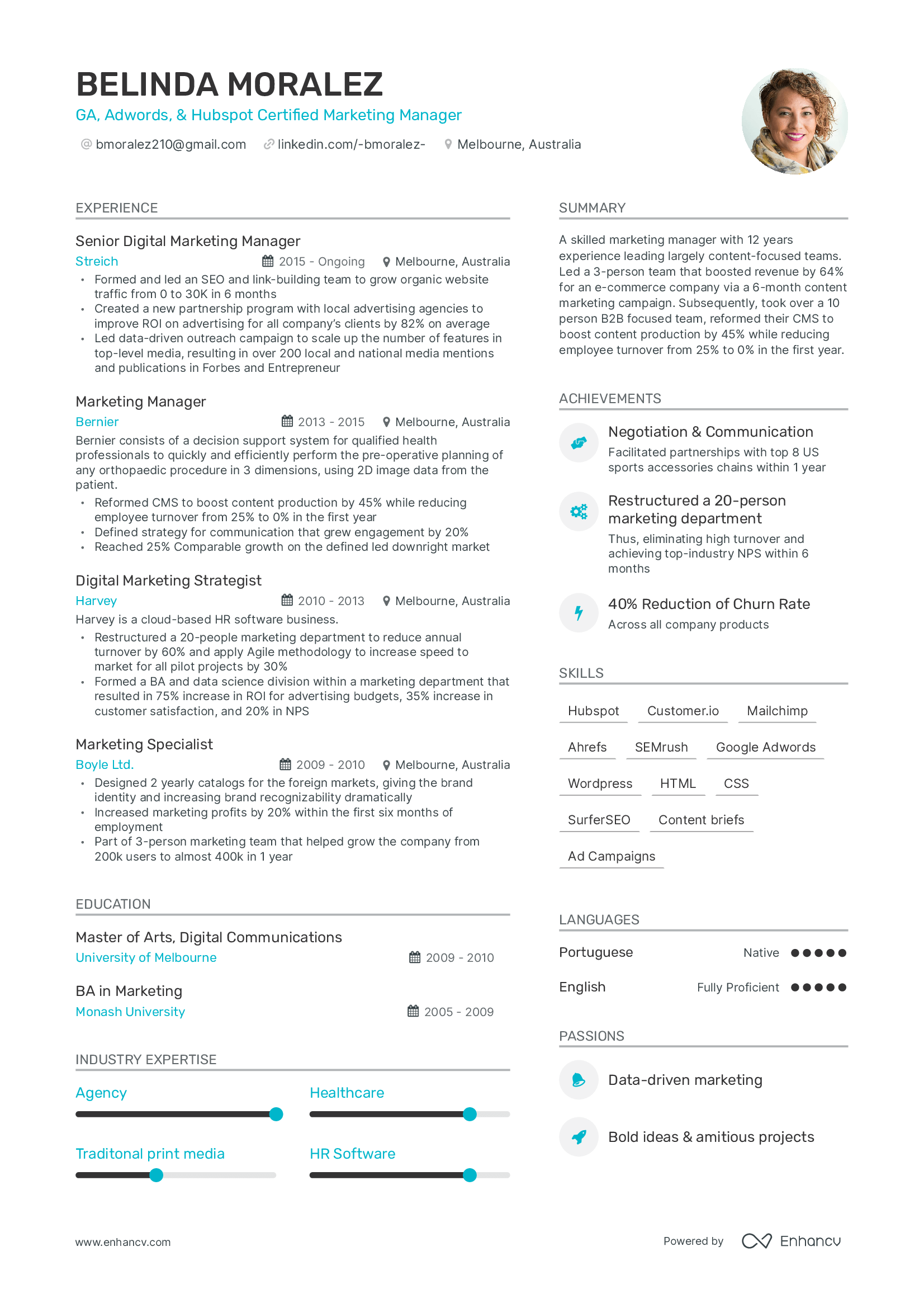
The most popular template for upper management roles, project managers and product owners.
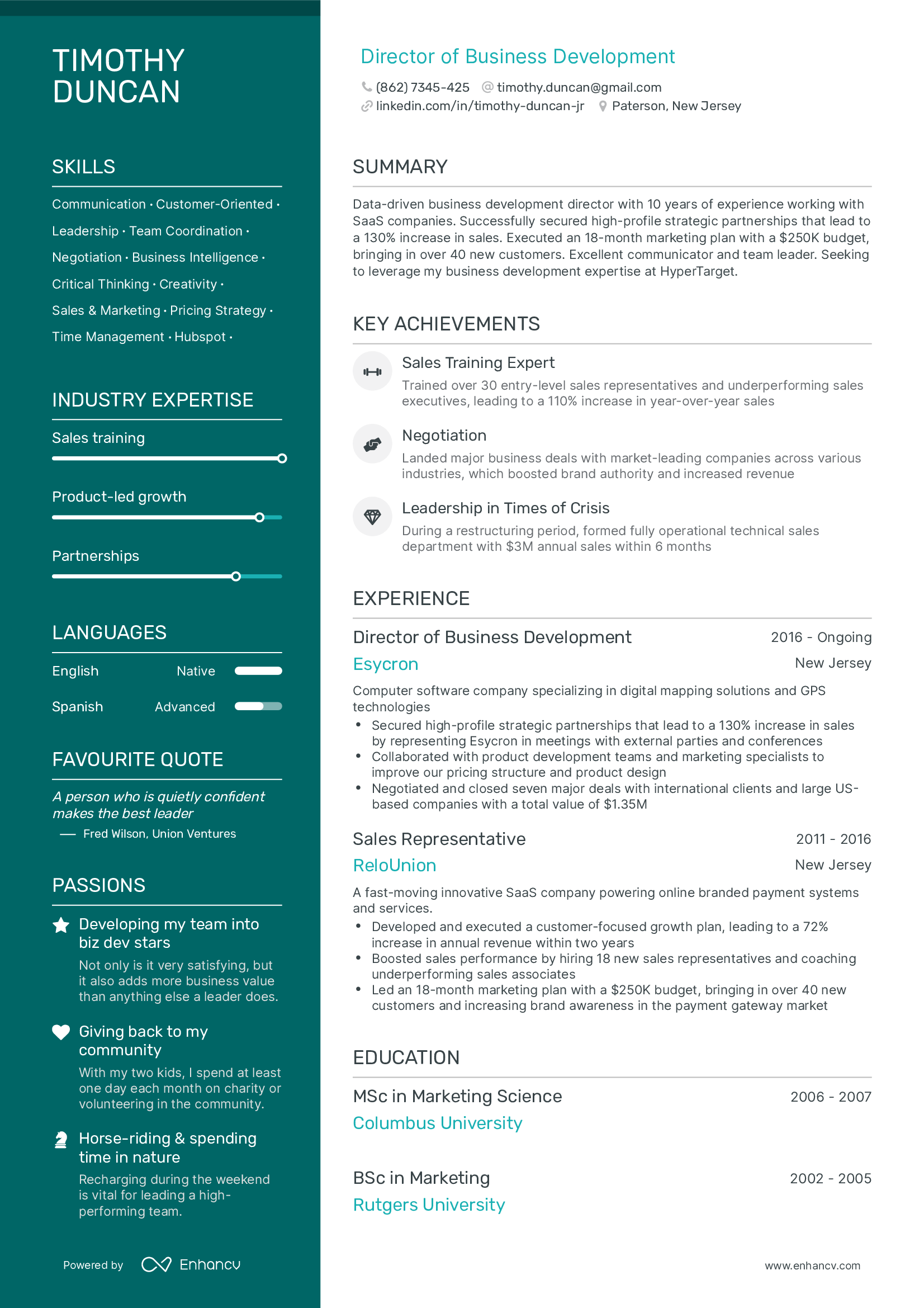
A refined template, especially great for positions where presentation is paramount: business development managers, sales leaders & other customer-facing roles.

A creative template that accents your header and makes recruiters want to read the rest. Built for any industry.

A timeline resume template. Organized neatly with a Timeline to show your career progress. For experienced professionals.

Are you a software engineer or a data scientist with a lot of skills & projects to list on your resume? This template allows you to create a perfect one-page resume.
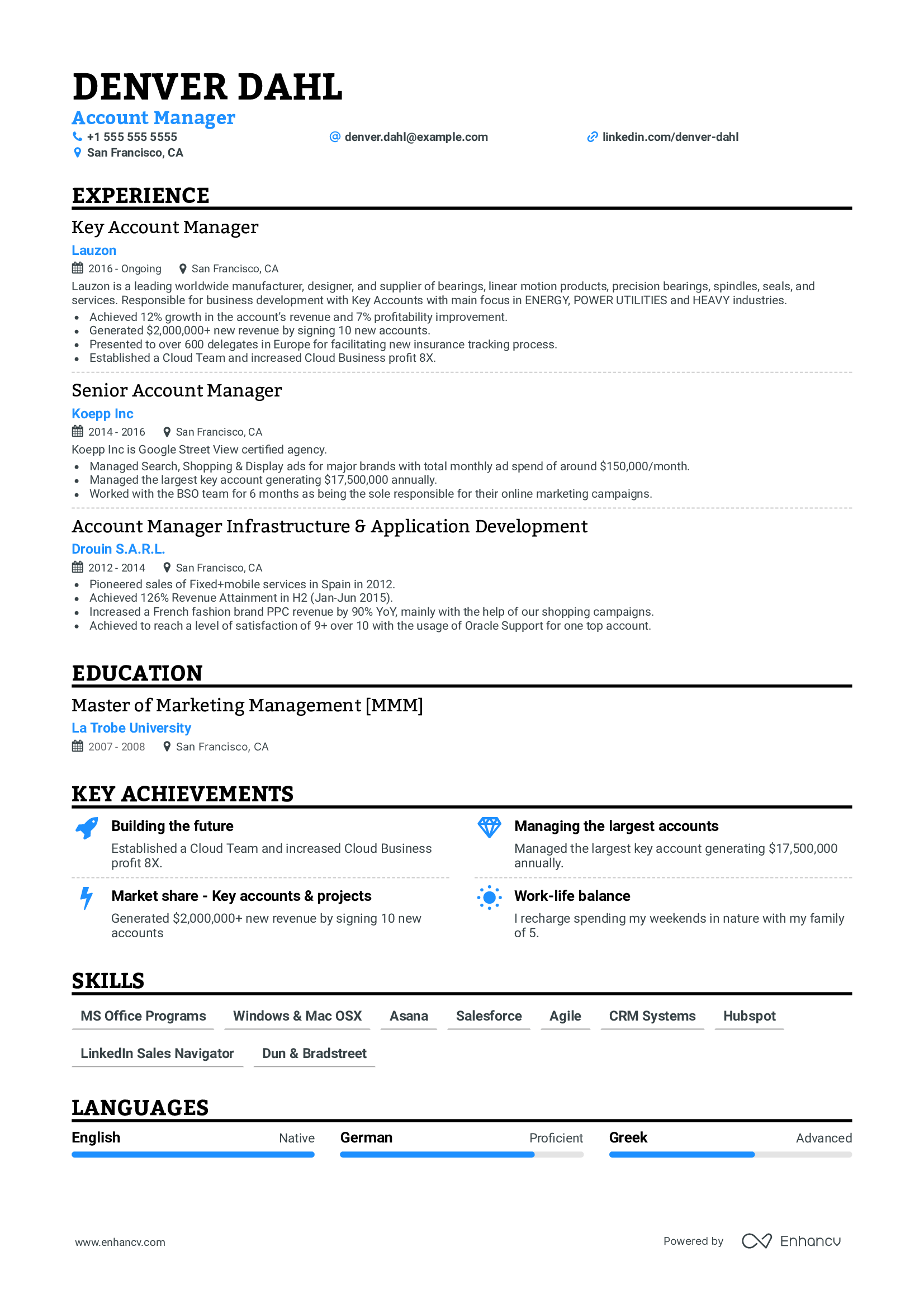
Single Column
Free, simple resume template. Easily readable by both humans and ATS bots.
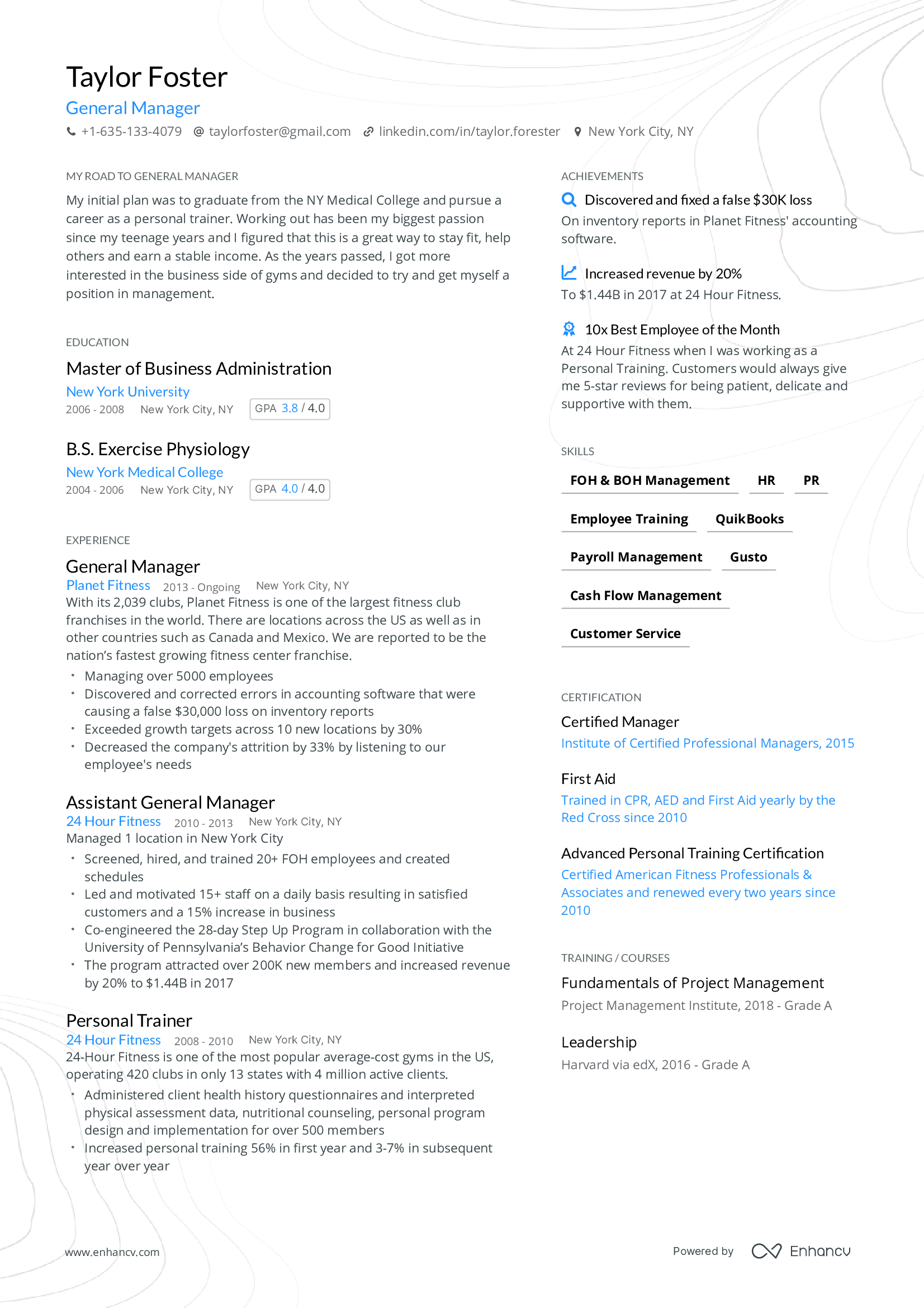
Designed as a one-page resume template for mid-level roles with 3-10 years of experience.
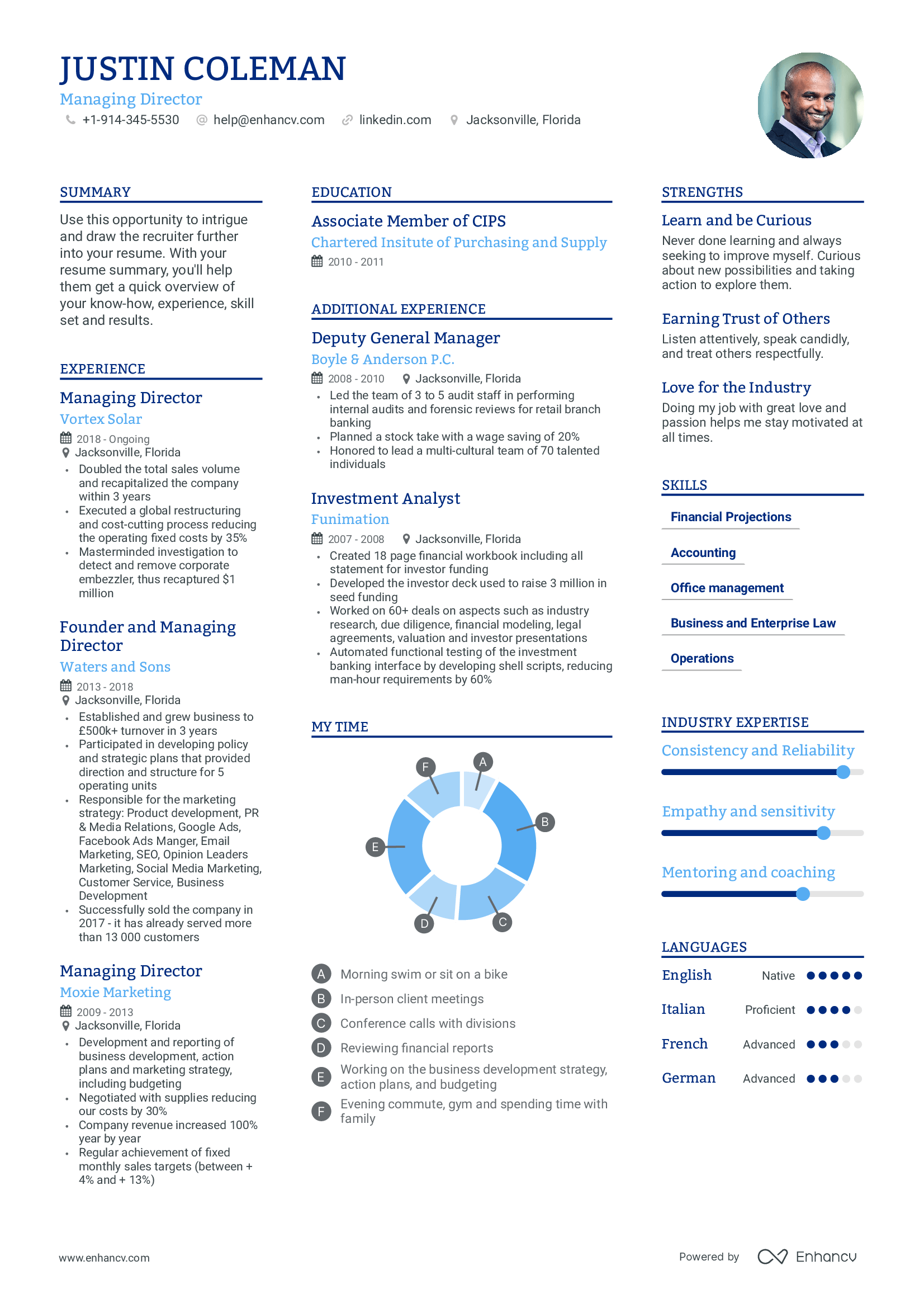
Multicolumn
Multicolumn resume template. Made for executives to fit additional info in a third column.
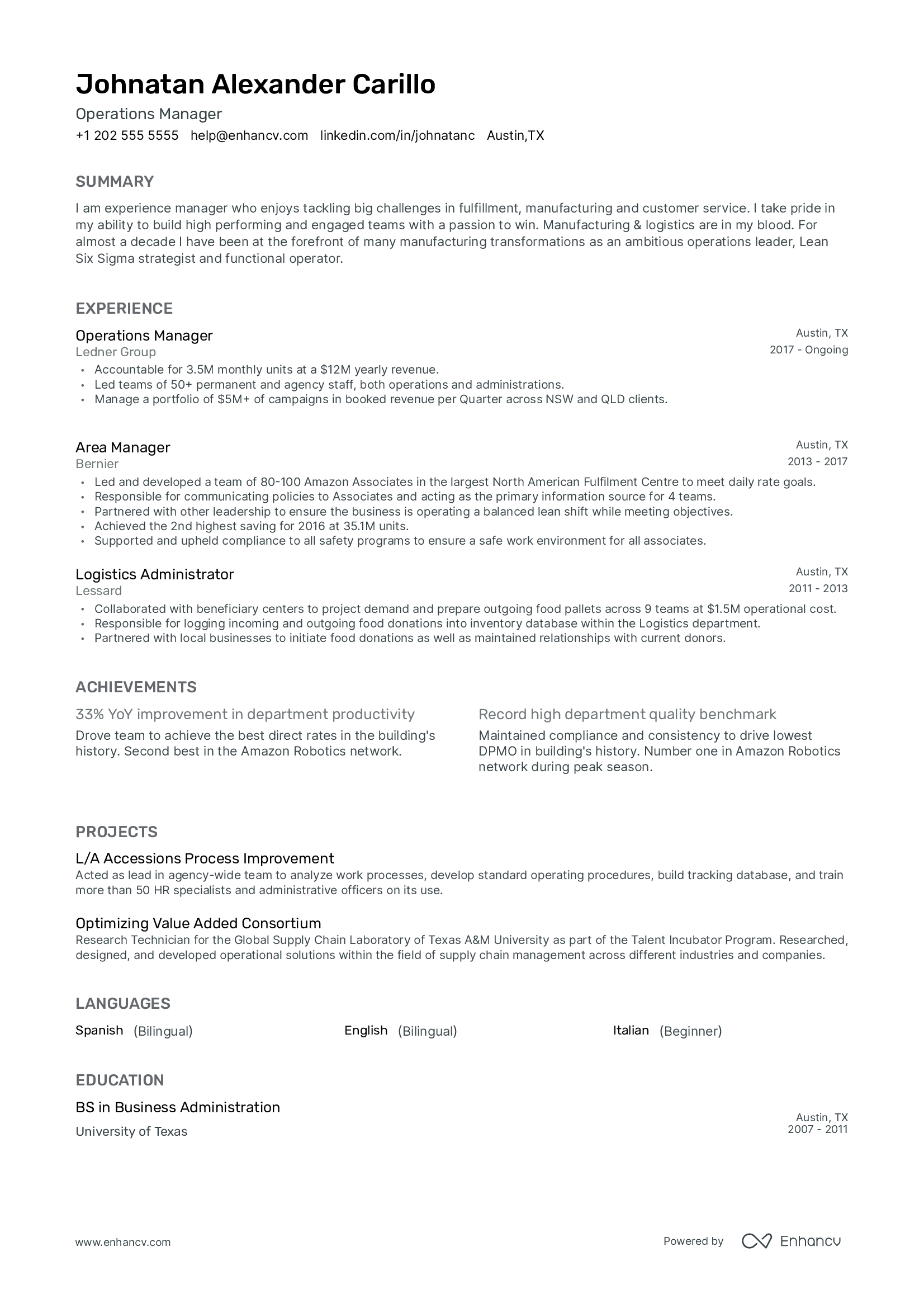
Traditional resume template. Fitting for conservative industries.
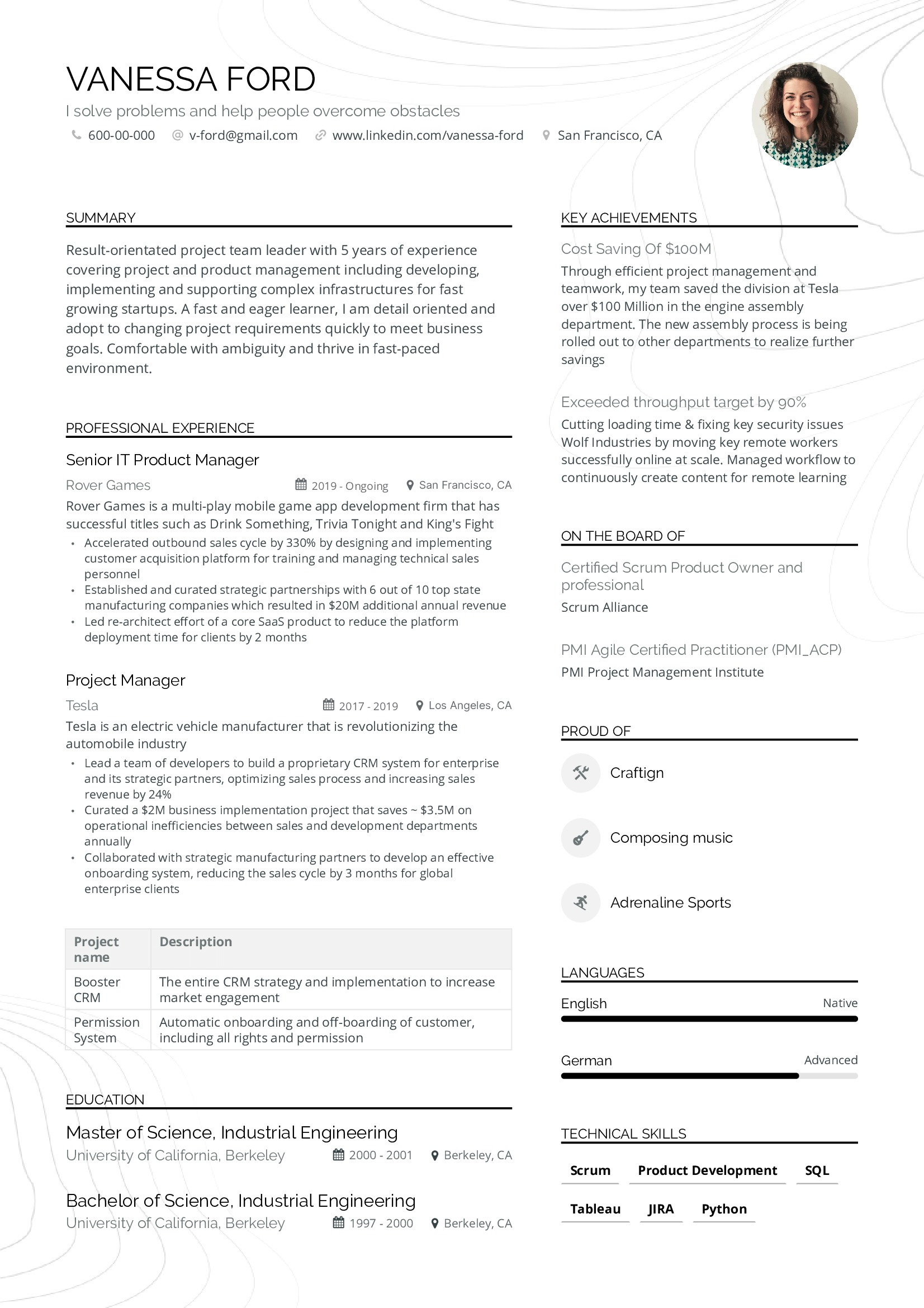
High Performer
Data-focused resume template. Perfect for project and product managers.

Minimalistic resume template. Blends whitespace and content, without clutter.
Resume Templates by job
Unleash the full potential of your career with professionally vetted resume templates. Take a look at samples from real resumes that helped people get hired at top companies in your field, and build a job-winning resume yourself.
Search more resume examples by job
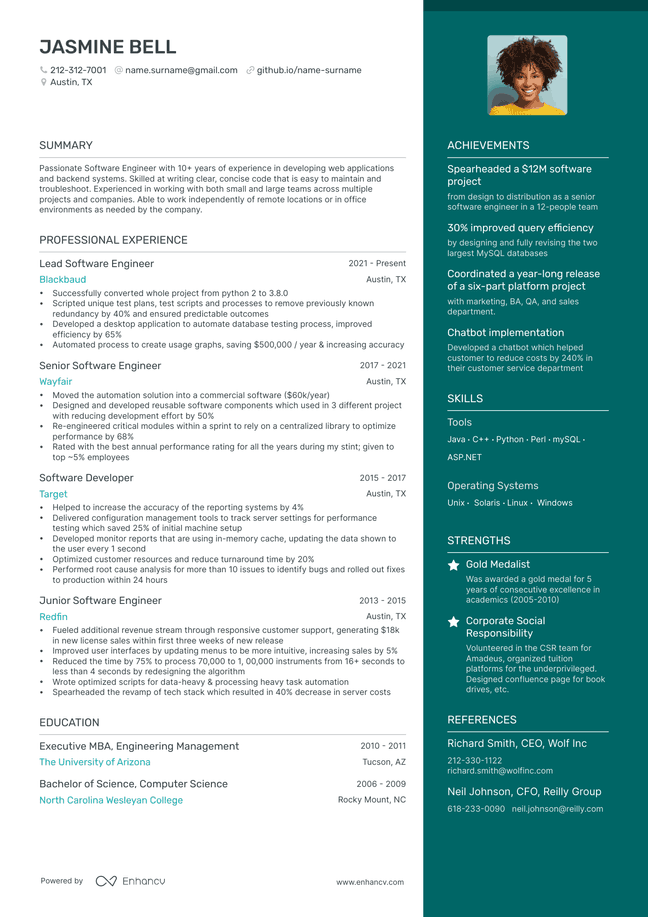
Software Engineer
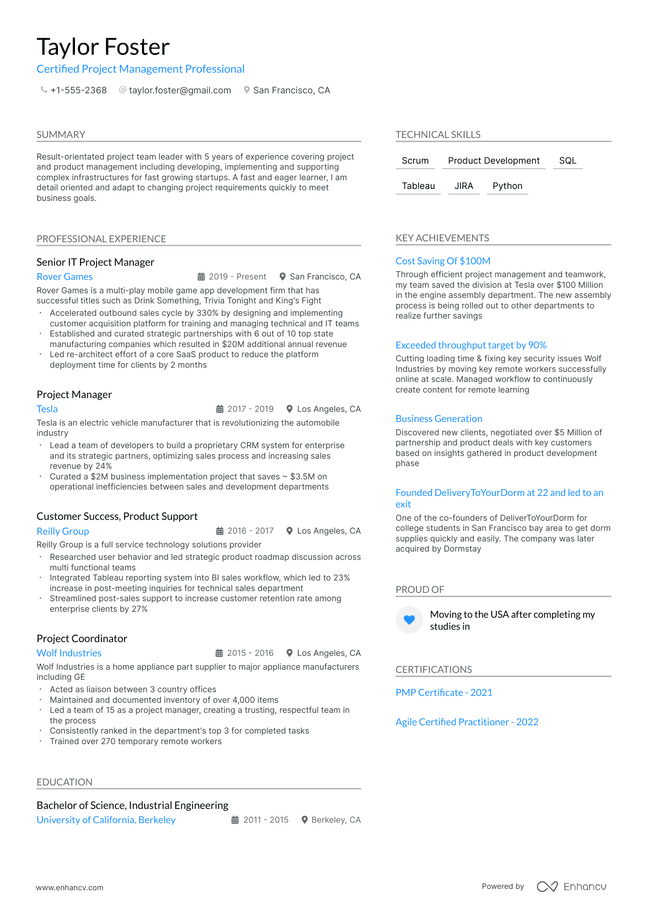
Project Manager

Product Manager

Account Manager
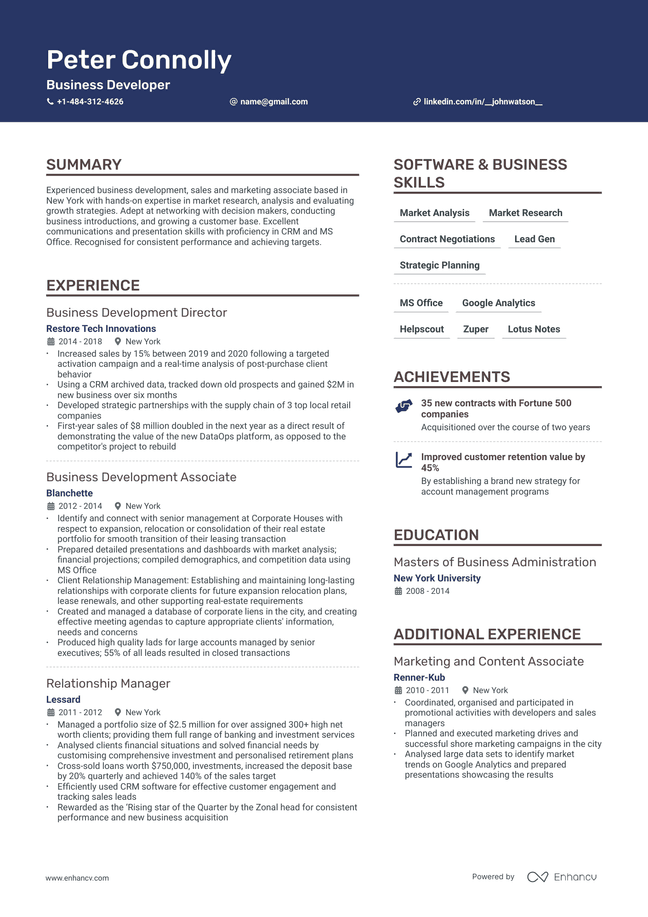
Business Development
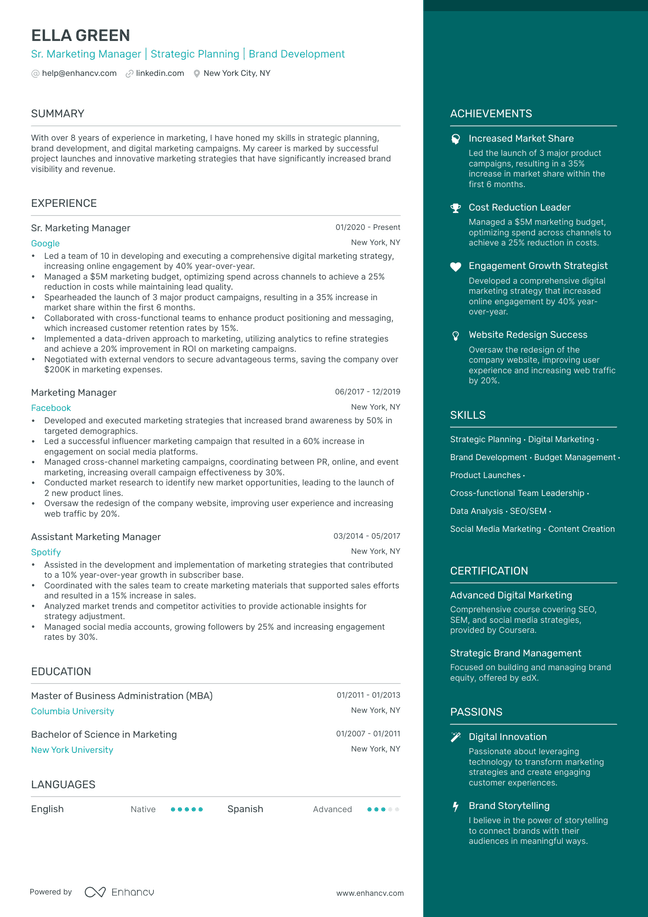
Marketing Manager
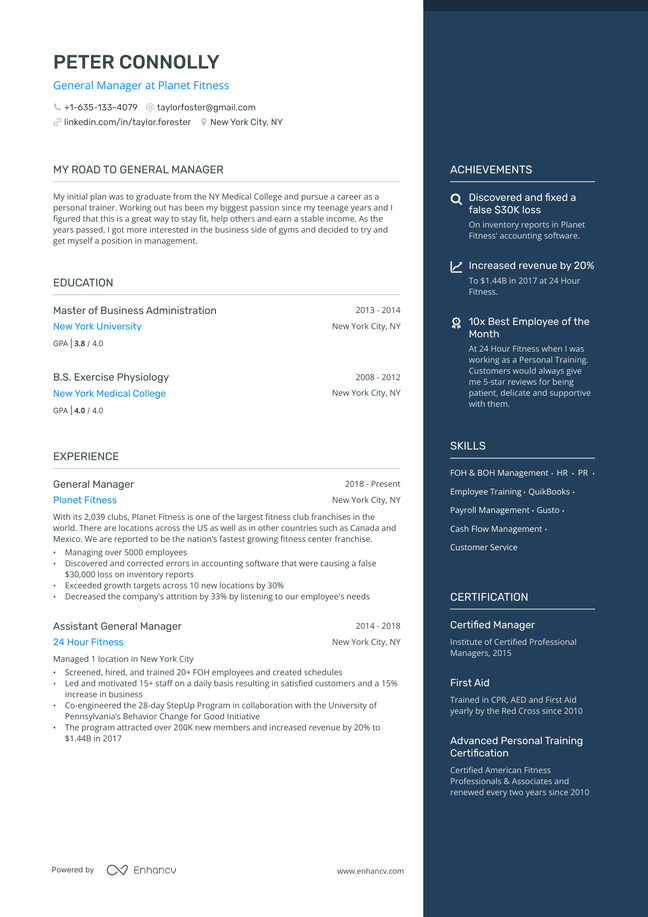
General Manager

Operations Manager

Business Analyst
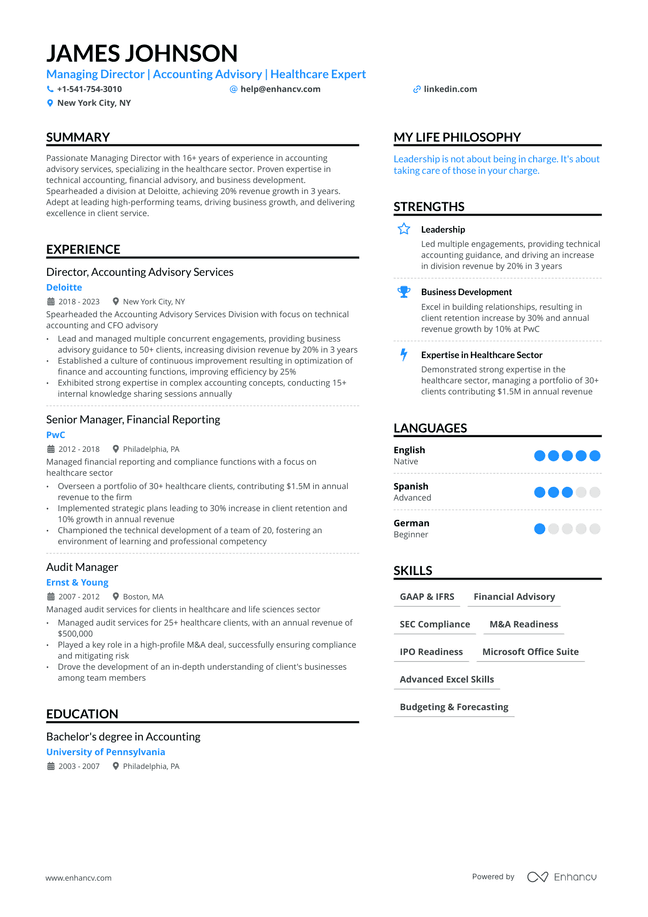
Managing Director
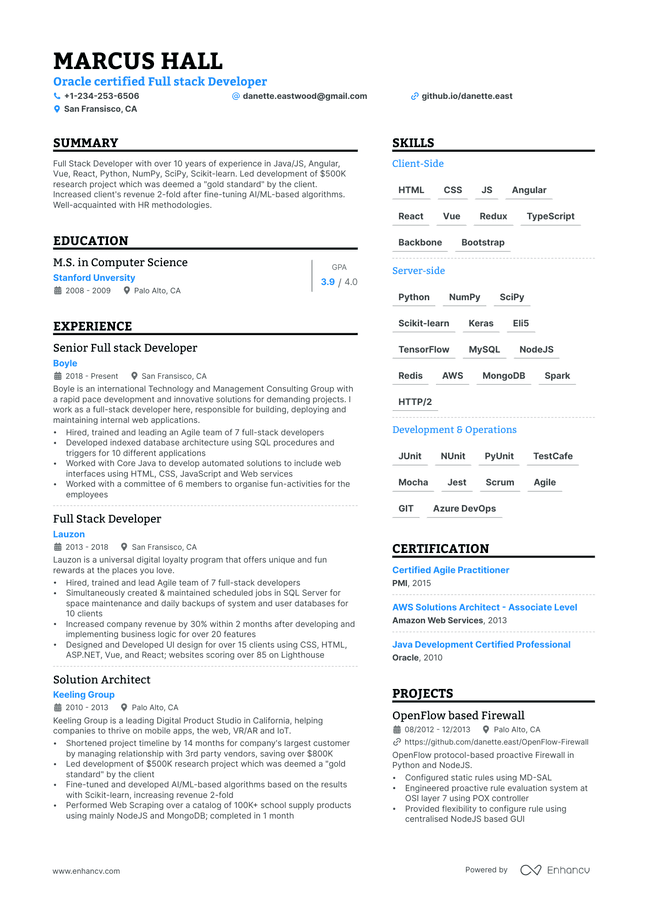
Full-Stack Developer
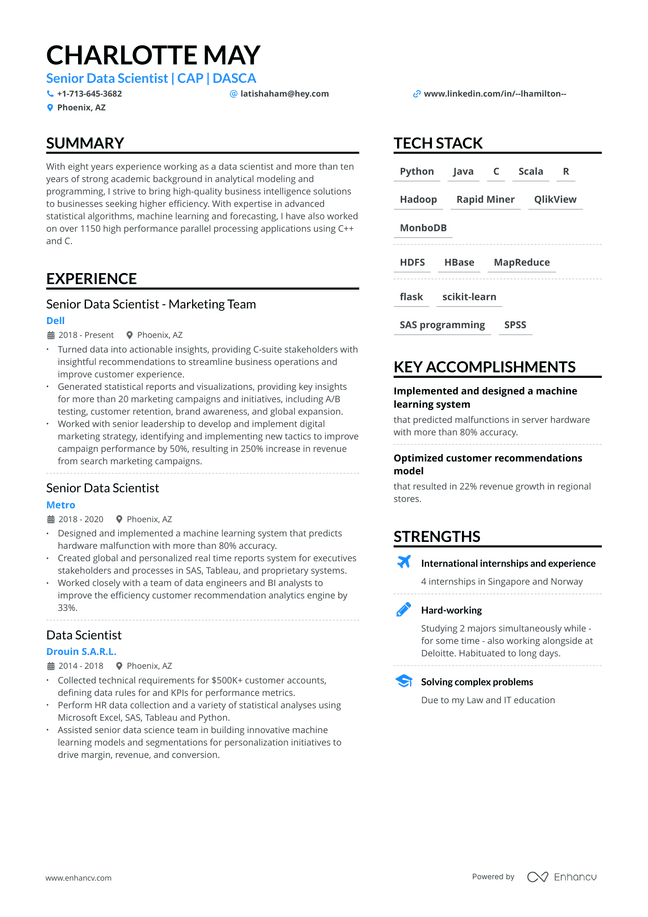
Data Scientist
Resume templates by experience.
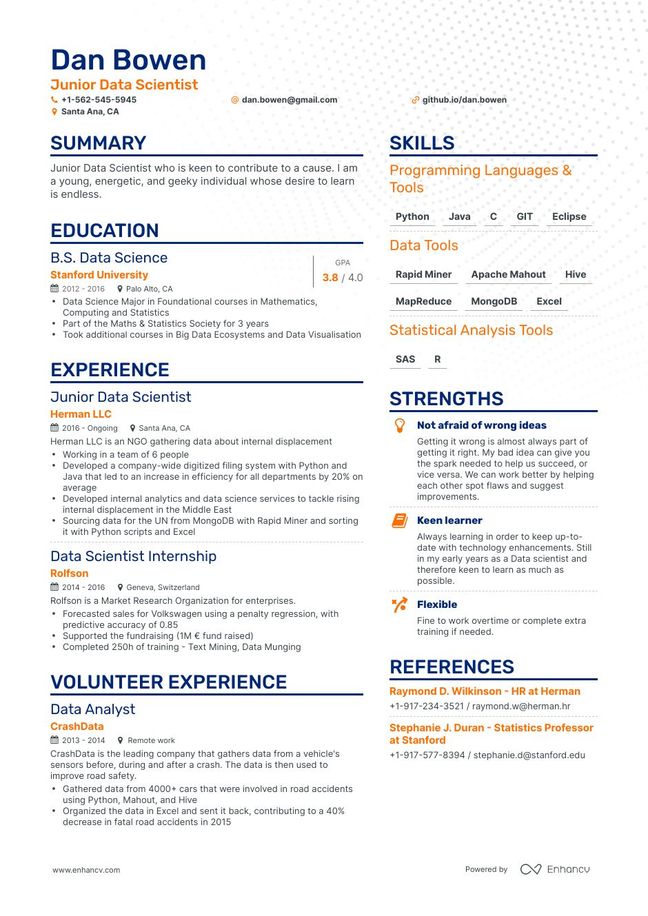
(1-3 years of experience)
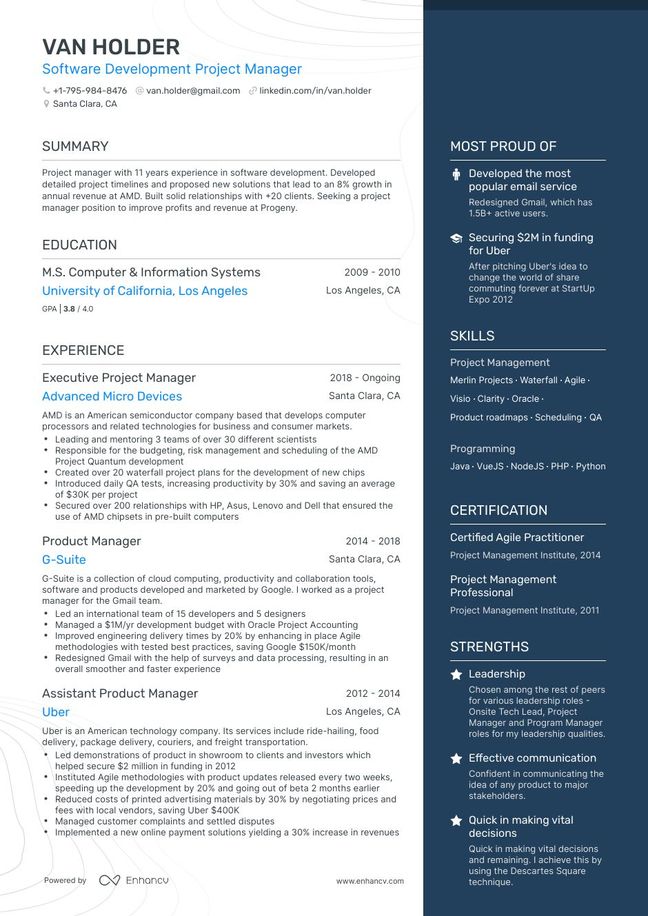
(3-7+ years of experience)
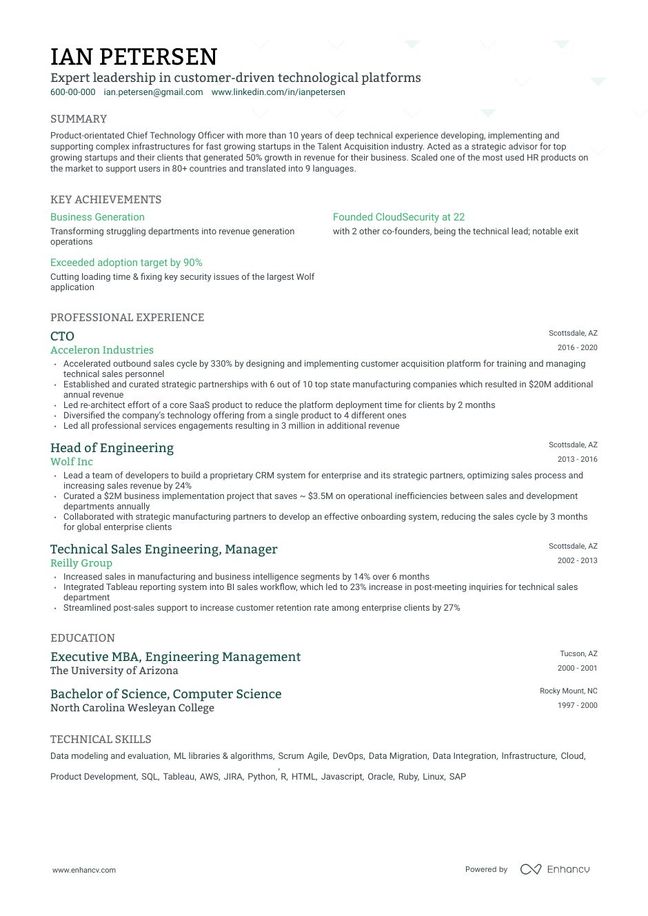
10+ years of experience)
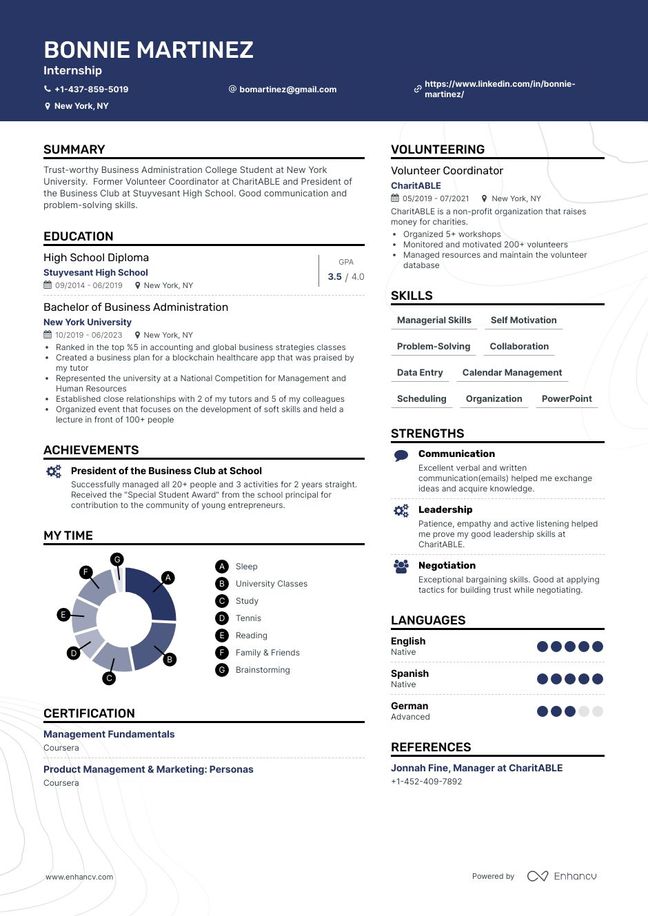
Entry Level
(no prior experience)
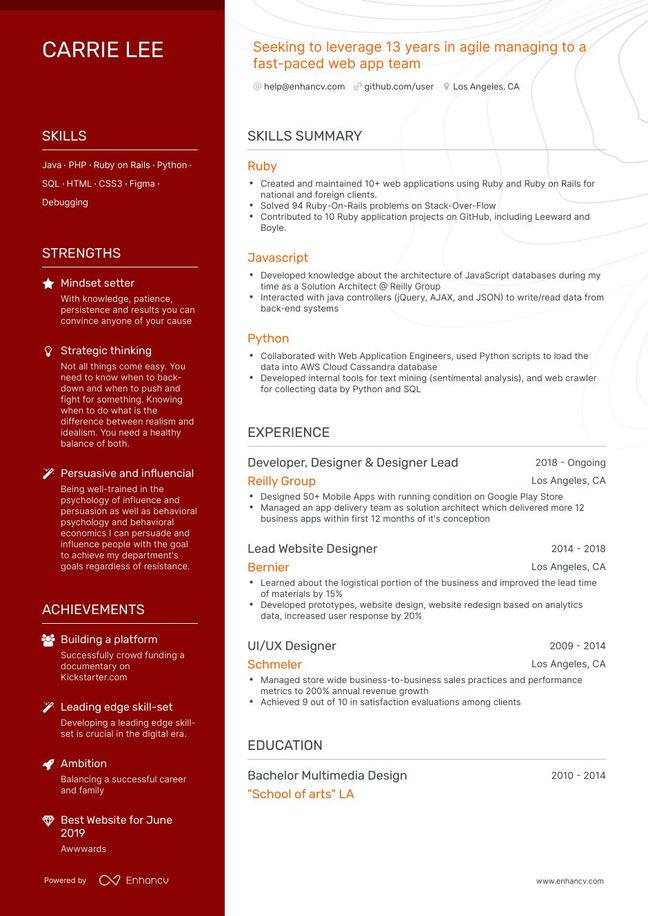
Career Change
Resume templates by format.

Combination Resume Templates

Corporate Resume Templates

Infographic Resume Templates
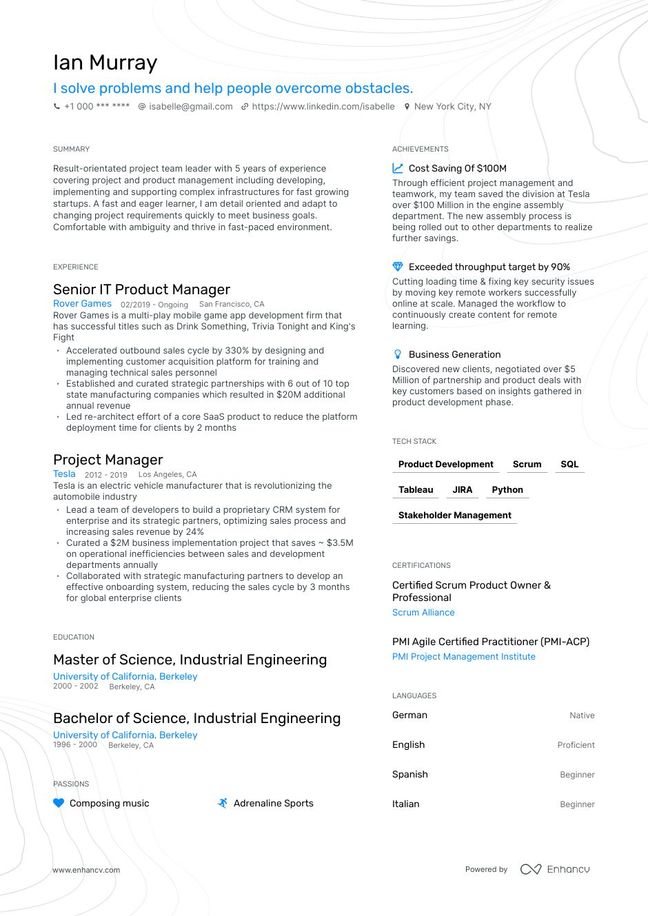
One Page Resume Templates

Timeline Resume Templates

Chronological Resume Templates

Functional Resume Templates

Minimalist Resume Templates

Two Column Resume Templates
- Modern Resume Templates

- Simple Resume Templates
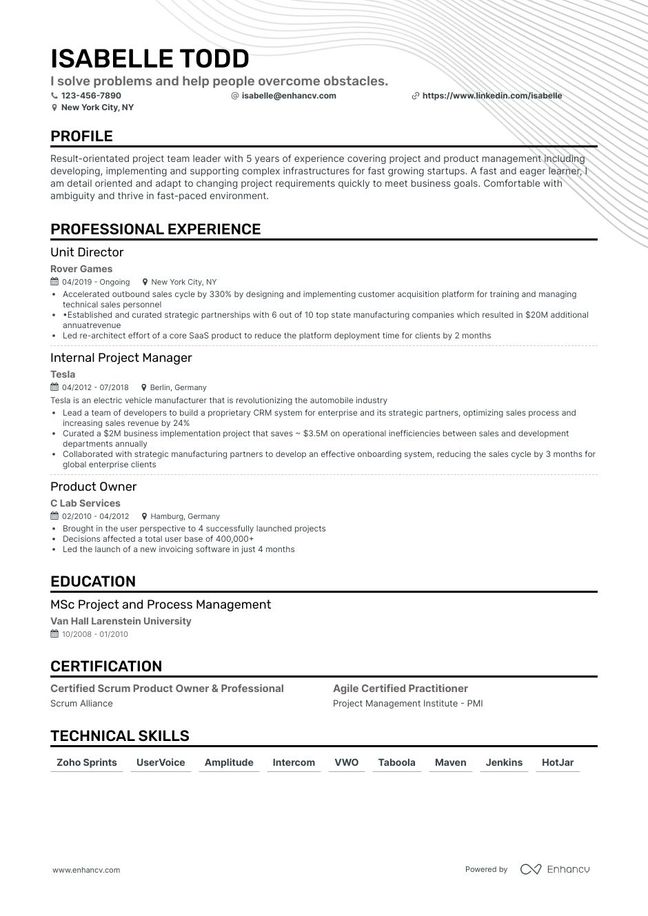
- Create Resume
- Terms of Service
- Privacy Policy
- Cookie Preferences
- Resume Examples
- AI Resume Builder
- Resume Summary Generator
- Resume Formats
- Resume Checker
- Resume Skills
- How to Write a Resume
- Cover Letter Builder
- Cover Letter Examples
- Cover Letter Templates
- Cover Letter Formats
- How to Write a Cover Letter
- Resume Guides
- Cover Letter Guides
- Job Interview Guides
- Job Interview Questions
- Career Resources
- Meet our customers
- Career resources
- English (UK)
- French (FR)
- German (DE)
- Spanish (ES)
- Swedish (SE)
© 2024 . All rights reserved.
Made with love by people who care.
- What is Career Pathways?
- Architecture, Manufacturing , Natural Resources and Agriculture
- Arts, Communications, Media and Marketing
- Business, Public Service and Tourism
- Healthcare and Health Sciences
- Human Services, Consulting and Education
- Artificial Intelligence
- Science, Technology, Engineering and Mathematics
- First & Second Year Students
- First Generation Students
- International Students
- Students With Disabilities
- Veteran Students
- Community Based Learning
- Creative & Entrepreneurial Works
- Global & Sociocultural Learning
- Internship, Co-Op & Work Based Learning
- Leadership & Involvement
- Professional Exploration & Development
- Featured Jobs
- Featured Internships
- Expand Your Network / Mentor
- Explore Your Interests / Self Assessment
- Job Market Data
- Negotiate an Offer
- Prepare for an Interview
- Prepare for Graduate School
- Search for a Job / Internship
- Academic Job Search Documents
- Create a Resume
- Create a Curriculum Vitae (CV)
- Create a Cover Letter
- Learn about Portfolios
- Learn all about LinkedIn
- Write a Personal Statement
- Professional Communication
- Molm Family Gator Career Career Closet
- Career Fairs
- Career Planning Appointments
- Career Prep Process
- Career Readiness Check-in
- Express Drop-In
- Industry Connections
- What Can I Do With This Major?
How to Build Experience
- Share This: Share How to Build Experience on Facebook Share How to Build Experience on LinkedIn Share How to Build Experience on X
Building experience is an important part of the college experience and essential to preparing for next steps. This guide walks through the variety of different types of experience and how they can be beneficial.

An official website of the United States government
Here's how you know
Official websites use .gov A .gov website belongs to an official government organization in the United States.
Secure .gov websites use HTTPS A lock ( Lock Locked padlock ) or https:// means you've safely connected to the .gov website. Share sensitive information only on official, secure websites.
How to supply work experience
In this section you'll enter your relevant work experiences. If your resume is confidential, any work experience with an end date of 'present' will not be visible to Federal recruiters performing resume searches. To complete this section, enter information and click 'add work experience.
See below for additional information on selected fields:
Employee Information
Please enter the company or agency name; your formal job title (e.g., Database Administrator); start and end date; and ending salary.
Is this a Federal Civilian position?
Federal experience includes positions you have held as a civilian employee paid by an agency of the Federal government. The pay plan, series, and grade fields refer to Executive Branch competitive positions and are not mandatory fields. If your experience does not fit, simply leave those fields blank.
Active duty military members or experience working for a private contractor of the U.S. government do not qualify as Federal positions for this purpose.
Duties, Accomplishments and Related Skills
Describing your duties, accomplishments and related skills can be challenging. To help you do this more effectively, take a minute to review the suggestions included below.
Focus On Your Goals
Your resume should showcase the skills you possess, and how they relate to the field you want to enter and the job(s) you are seeking. Think about your career goals. Then narrow your scope to the positions that will further those goals. Once your career goals are clear, it will be easier to describe your skills in a meaningful way.
Review Job Announcements
Before you describe your own duties, accomplishments, and skills, try reviewing relevant job descriptions. Once you have an understanding of the competencies required for the jobs you are interested in, you can relate those requirements to your own experience. After reviewing the descriptions, list your matching skills, experience, training, and education. Use words and phrases used in the announcements. Incorporate other commonly used technical terms.
Describe Your Experience
When listing your past jobs, concentrate on experiences that are relevant to your career goals and the position you are applying to. For instance, if you had a summer clerical job and you are looking to apply for a professional position, you do not need to list that job. With the exception of your current position, omit any job that does not show how your skills and experiences relate to the type of position you are seeking. Think about the projects you worked on; what your specific duties were; what you needed to know to do the job; the tools, software, or equipment you used; what you accomplished.
Include Achievements and Contributions
Did your supervisor require that you list your accomplishments for performance reviews? If so, you can use those documents as a guide. If not, try listing your accomplishments from the last five years. Focus on challenges you met, problems you solved, results achieved, and any awards, promotions, and special benefits you received. It's better to describe your accomplishments, than list your responsibilities. Writing Tips
When writing about a work experience, keep your description concise, clear and organized. Use simple sentences that cite specific examples. Name any tool, software, or equipment you used, and any specialized knowledge you acquired. Instead of saying, 'Performed the full range of project management duties for a new information system,' use concrete examples: 'Used Microsoft Project to develop timelines. Prepared budget requests; hired staff; selected vendors; negotiated contracts; designed and implemented a new UNIX client-server information system.' Use action word phrases (e.g., designed and implemented new organizational structure plan; negotiated contracts up to 90K; delivered report on waste management).
When you're finished, ask yourself the following questions:
- Would someone who is not familiar with my occupational background understand the kind of work I do?
- Is there nonessential information (nice to have, but not helpful in meeting mandatory qualification requirements) in what I have written?
- Have I omitted any relevant experience or skills I possess that might distinguish me from other candidates if my resume reaches the desk of a selecting official?
- Have I adequately described major characteristics of my occupation or background and skills that are most common to my occupation?
Still need help?
ATS Resume Templates
Download an ATS-friendly resume template for free. These templates can be edited in Microsoft Word and can be accurately scanned by an applicant tracking system.
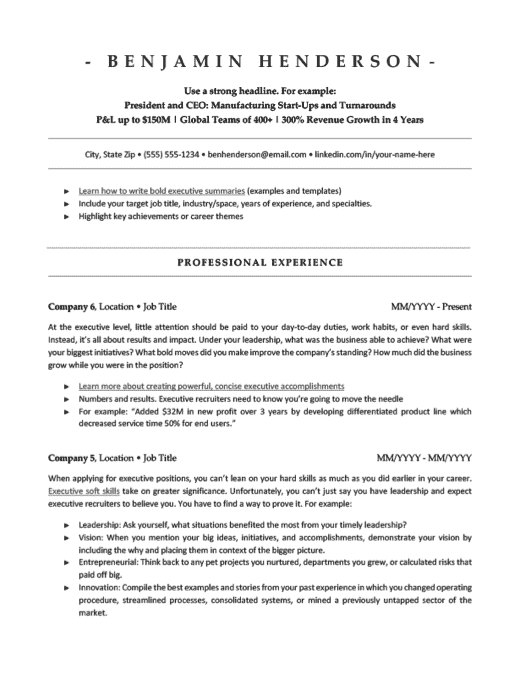
If you’ve made it to this page, then you probably already know more about applicant tracking systems (ATS) than the average job seeker. That gives you an advantage! Why?
Many companies use ATS to manage resumes and applications. In fact, Jobscan research shows that over 97% of Fortune 500 companies use an ATS.
If an ATS can’t read or understand the information on your resume, then your application might not be seen when a recruiter searches for candidates with specific skills or experience – even if you have those skills or the experience!
Your resume needs to be ATS-friendly in order to give you the best chance of getting a job interview. That means that you need an ATS resume template.
We’ve designed 15 ATS resume templates that can be downloaded as Microsoft Word files and easily edited. Download one for free or use our free resume builder to get a customized ATS-friendly resume in minutes.
Free ATS Resume Templates
Executive and Management ATS-Friendly Resume Templates
As a leader, you want your experience and accomplishments to shine. These resume templates give you opportunities to show the measurable results you’ve achieved, as well as your hard and soft skills .
Using correct formatting is critical here. The ATS needs to be able to parse all of that vital information and categorize it correctly. You also need your resume to be searchable by an ATS so that when a recruiter filters candidates by skills, your application stays on the list.

Entry-Level ATS-Friendly Resume Templates
You might not think you have a lot to show on your resume, but you do! These templates provide sections where you can highlight your education, internships, volunteer experience , personal accomplishments, and more.
An ATS-friendly resume will help you get found by recruiters and hiring managers. This is important because an entry-level position could have hundreds of applicants! Use these templates to make sure the ATS picks up your skills and experience.
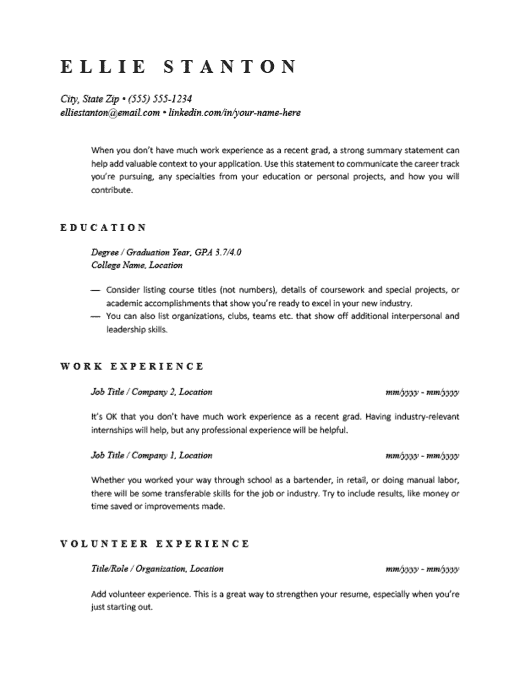
Make your resume faster with our free resume builder
Write your resume the free and easy way with the only resume builder designed specifically with ATS-compliant resume templates.
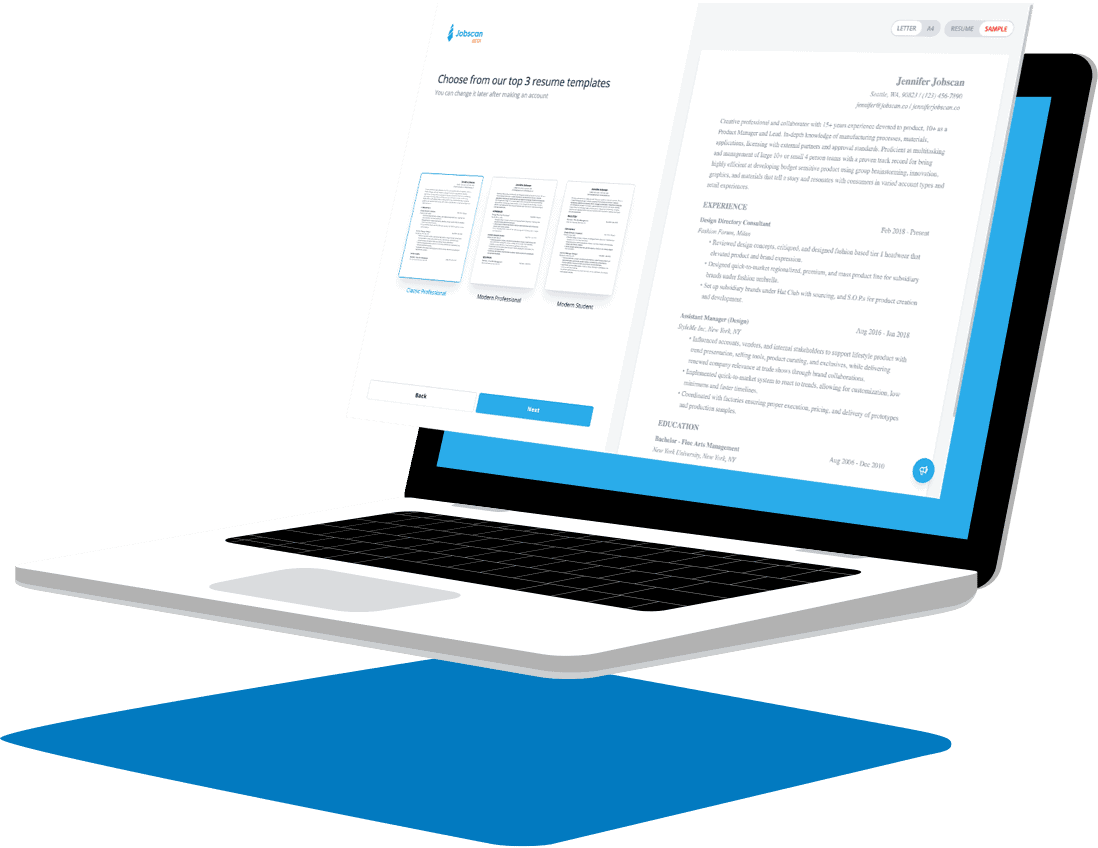
Jobscan users have been hired by:
ATS Resume Templates - What You Need to Know
How to make the perfect ats resume.
Remember, an ATS is just a computer filing system. It needs to be able to scan and understand the text on your resume in order to correctly parse the information and sort it properly.
An ATS will never auto-reject a resume, but an ATS optimized resume does make it easier for a recruiter to find you among the sea of applicants.
Even more importantly, an ATS-friendly resume naturally follows expert-recommended resume writing standards as well. That means that when the recruiter personally views your resume, it will include the relevant information they’re looking for and will be formatted in a way that makes it easier to read
Follow these tips for making the perfect ATS resume :
1. Tailor your resume to the job you are applying for
Focus on quality over quantity. Each job you apply for is unique, even if they all have the same title. Every company has different needs for that role. The job description will make it clear which hard skills, soft skills, experience, and education the company is looking for. So tailor your resume to show them that you are the perfect candidate.
Tailoring each and every resume can be time consuming, but it’s worth the effort!
You can speed up this process by using a tool like Jobscan’s resume scanner . Powered by AI-technology , this tool analyzes your resume against the job description and provides you with a resume score that tells you how closely your resume matches the job description. It also tells you exactly what you need to do to increase your score.
2. Match your resume keywords to skills found in the job description
Recruiters might use an ATS’ search function to find applicants with specific skills. How do you know what skills they will search for? By examining the job listing. Use a resume scanner to automatically pick out the hard and soft skills the recruiter might search for, and then include those on your resume.
Even if the recruiter doesn’t search applications for those skills, they’ll definitely be looking for mentions of them on each resume they review.
3. Use long-form and acronym versions of keywords
Some ATS will only return resumes with the exact keywords the recruiters would search for. For example, if you included “Search Engine Optimization” in your resume but the recruiter searched for “SEO,” your profile may not appear in the results. Try to include both the acronym and the unabbreviated form of the term.
Use a tool like Jobscan’s resume fixer to make sure your resume doesn’t contain mistakes that will eliminate you from consideration.
4. Use Chronological or Hybrid resume format to write your resume .
Recruiters do not like the functional resume format . Unless you’re making a career change, a functional resume is going to work against you. (And even then, we recommend you steer clear of the format for a career change resume .)
The best format for the ATS is traditional reverse chronological. You can also use chronological and hybrid resume formats as these are familiar to most recruiters.
5. Use an easy-to-read, traditional font
For readability, use a traditional serif or sans serif font. Untraditional or “fancy” fonts can cause parsing errors, which means the full text of your resume won’t be searchable.
6. Use standard resume section headings
Section headers like “Where I’ve Been” in place of “Work Experience” will confuse applicant tracking systems, causing them to organize information incorrectly.
7. Save your file as a .docx if possible
A docx file is most compatible with ATS.
What is the best resume format for ATS?
There are three standard resume formats to choose from in your job search. They shape your first impression and determine the way recruiters and hiring managers view your fit as an applicant.
Your resume formatting can also determine how well your resume is parsed within an applicant tracking system (ATS) and how likely you are to be noticed as a result.
Regardless of the format you use, the most important thing is to use standard section headings like Experience, Skills, and Education. That will make it easier for the ATS to categorize the text.
How to tailor your ATS-friendly resume to a job
Tailoring your resume proves to recruiters that you’re an experienced professional. Most importantly, it shows them that you’re the perfect fit for this role.
Follow these three steps for tailoring your resume to a job description:
1. Examine the specific job description of the position
Go line by line through the job description and ask yourself these questions:
- “Does my resume experience section clearly state that I can do what’s required of this role?”
- “Am I using the same language found in the job description or job posting?”
You might find several different or missing skills and keywords in your generic resume.
2. Match skills and keywords from the job description
Mirroring the language, keywords, and buzzwords found within the job description is the easiest way to demonstrate you’re a better match than the competition.
The best way to show you’re the best fit for the position is to take words from the job posting and strategically put them in your job descriptions and other resume sections. A resume scanner will automatically pull out these keywords in seconds and speed up this process.
3. Write your job title clearly
Recruiters might search for people who have done the job they’re hiring, so list your job titles clearly and match the titles to the one in the job posting when possible. If you haven’t held the job before, list it under your name at the top or as part of your summary section.
What is Applicant Tracking Software (ATS)?
An applicant tracking system (ATS) is software used to assist with human resources, recruitment, and hiring. While each system offers a different package of features, applicant tracking systems are primarily used to help hiring companies organize and navigate large numbers of applicants.
For example, an ATS stores job candidate information like resumes, cover letters, references, and other recruitment and hiring data that HR teams can easily access and organize. It will also track job candidates and their application status throughout the hiring pipeline.
Ultimately, an ATS automates time-consuming administrative tasks such as manually screening applicants, reading resumes, scheduling interviews, and sending notifications and emails to job candidates and employees.
Can you add graphics to your resume?
When it comes to creating an ATS-friendly resume , the rule is: The simpler, the better. ATS are improving at scanning different formatting features, but not all of them are good at this.
Adding graphics and images could cause ATS parsing errors , which means the text on your resume won’t be fully searchable or accurately categorized by an ATS. We recommend that job seekers err on the side of caution. Avoid graphics, images, and photos.

Are Google Docs or Microsoft resume templates ATS-friendly?
They can be. We talked about some formatting features to avoid on your resume – fancy graphics and non-traditional fonts. Those features can trip up an ATS, even if they’re on a Word document or Google Docs file.
However, as long as you follow the guidelines on this page, or use one of these ATS resume templates, you’ll be fine.
How to get your cover letter past the ATS?
To increase your cover letter’s chances of passing an ATS, focus on using a clean format without complex formatting, incorporate relevant keywords and phrases from the job description, and ensure that your content is easy for the ATS to parse.
Consider using a tool like Jobscan’s cover letter generator to help you create an ATS-friendly cover letter. If you already have a cover letter, run it through our cover letter checker tool to get personalized feedback on how to improve your cover letter and make it more compelling to employers.
More Resume Resources
Google Docs Resume Templates
Professional Resume Templates
Resume Builder
Resume Writing Guide
Score your resume and start optimizing it to get more job interviews

Protect your data
This site uses cookies and related technologies for site operation, and analytics as described in our Privacy Policy . You may choose to consent to our use of these technologies, reject non-essential technologies, or further manage your preferences.
- Resume and Cover Letter
- Guide to Writing a Great...
Guide to Writing a Great Resume with No Work Experience
16 min read · Updated on February 13, 2024

No work experience? No problem.
The ol' catch-22: you need a job to get experience, but you need experience to get a job. Either way, you need a resume, and what you don't need is to panic.
Just because you don't have skills that are relevant to the job, or experience in a traditional work setting, doesn't mean you can't craft a convincing first job resume. Whether you're a high school or college student, you may be wondering: how do you write a resume with no work experience? Well, we'll tell you with these expert tips.
1. Choose the best format for a resume with no experience
There are a few dominant resume templates in use today:
Chronological
Hybrid - a blend of the chronological and functional formats
A chronological resume format lists a candidate's work experience in reverse-chronological order and a functional resume format focuses on highlighting the candidate's hard and soft skills and achievements, rather than work experience. While the functional and hybrid resume formats can be attractive options for job seekers with little relevant experience, most employers and hiring managers prefer a chronological format.
Aside from hiring managers preferring it, it's best to use a reverse chronological resume for two additional reasons:
It's the most used format in the US, making it easy for hiring managers to review and find the information they're seeking
It's the most liked by employers' applicant tracking systems, or ATS. If an ATS can't read your resume properly, it might not get into the hands of a human reader - even if you're the perfect candidate for the job
The primary sections of a reverse chronological resume are:
The heading (with your contact information)
Resume summary
Work experience (which will be substituted with other sections when you have no work experience)
Education
2. Incorporate your contact information
Now that you've chosen the best format for a resume with no experience, it's time to complete each section. The first section of your resume is the header section. This is the section that includes your name and contact information. In this section, you'll provide:
Phone number
Email address
Location and zip code
LinkedIn or professional website URL (optional)
Your name should sit above your contact information in a larger font size than the rest of the information included in the header. You also want to ensure you use a professional sounding email address. Using something like “[email protected]” or “[email protected]” will likely come across as unprofessional and won't gain you any points for the “yes” pile. A good choice is to use your name (or a combination of your initials and surname), instead.
Here's an example of how to list your contact information at the top of your resume:
Joseph Smith
555.555.5555 | [email protected] | WV 26250 | linkedin.com/in/jsmith28
3. Include a strong summary statement
The next section of your resume, your Resume Summary, will fall just below your contact information. Your resume summary is not to be mistaken for a resume objective.
Resume objective statements , where you state exactly what career goals you wish to achieve, have mostly fallen out of fashion. This is largely because you want to focus on what you can do for the employer, not what the employer can do for you. A resume summary statement, on the other hand, sums up who you are professionally at the top of the page in two to five sentences and serves as the first impression you give a hiring manager to entice them to keep reading.
For a resume with no experience, your resume summary can still pack a punch. Include some of the key skills you have relevant to the job, while emphasizing your major and any type of experience that speaks to your ability to succeed.
Here's an example of a resume summary for a recent grad with a human resources degree:
Human resources graduate with diverse knowledge base in employee relations, benefits design, employment law, and policy design. Avid learner with solid written and verbal communication skills and a strong desire to support all levels within an organization for improved employee morale and productive collaboration.
4. Substitute the Work Experience section with other types of experience
Writing a resume with no experience can feel like a daunting task. Fortunately, recruiters and hiring managers are seeking candidates that have a robust background, regardless of experience level. Here are some sections you can substitute in lieu of a Work Experience section:
Internships
Graduate assistantships, extracurricular activities.
Volunteer Work
Hobbies and Interests
When you include these additional types of experiences on a resume, you can include them as a standalone section or create a “Relevant Experience” section. Depending on the type of experience you're including, you might find it's best to use a section heading that aligns with the type of experience (“Internships” for internships, “Volunteer Work,” for volunteer work, and so on).
Landing paid or unpaid college internships are one of the best weapons you have against "experience required." Not only do they give you some real-world work experience, they also allow you to network and make connections that can put you in a job later. When applying for a job without experience, be sure to list any internships you've completed.
If you haven't had an internship, consider applying for one as a step before an entry-level job.
Here's an example of how to include an internship on your resume:
Finance Intern
New York Secretary of State Office, New York, NY
Jan 2021 - May 2021
Reconciled budget sheets for quarterly processing
Supported accounting team in year end tax return audits
Analyzed 15 budget reports over a two-month period to ensure accurate data reporting
Similar to internships, a graduate assistantship secured during school is also a great way to gain valuable experience to include on a resume. Graduate assistantships are paid opportunities provided to graduate students. They typically involve part-time teaching or research within their field of study.
Here's an example of how to include an assistantship on your resume:
HR Graduate Assistant
West Virginia University School of Business and Economics, Morgantown, WV
August 2020 - May 2021
Reviewed 100 collective bargaining agreements to identify and document similarities and inconsistencies throughout
Worked with academic Professors to develop research guidelines for future assistants
Volunteer work
When surveyed, the majority of employers say that they take volunteer experience listed on your resume , such as being a soup kitchen volunteer, into consideration alongside paid work experience. So any volunteer work that highlights your talents or a new skill should be put on your well-prepared resume.
You'll list volunteer work in a similar way to how you would list internships and actual work experience:
Animal Transport Volunteer
Friends for Life Animal Shelter, Philippi, VA
April 2022 - Present
Working with local shelters to transport animals to and from shelters and foster homes
Assisting in cleaning kennels and common areas to support sanitation efforts
Spearheading animal supply drive, collecting $10K worth of supplies
Though it might not seem like it at first, extracurricular activities can add a lot of value to your resume in lieu of work experience, if you can relate them to the job you're applying to. For example, if you were an officer for a club during college or a captain of a sports team, these roles speak to leadership ability.
In general, these types of activities show you have the ability to collaborate with others. It also shows you have the ability to keep up with school work while being involved in other areas outside of school, which speaks to time management and organizational skills.
Here are some of the top extracurricular activities to include on a resume with no experience, as well of some of the skills they help to highlight:
Artistic endeavors: speaks to creativity, problem solving, perseverance, ability to learn
Sports: speaks to teamwork, collaboration, hard work, problem solving, conflict resolution
Club leadership roles: speaks to leadership, organization, perseverance, time management
General club membership: speaks to time management, community involvement, prioritizing
Student government: speaks to leadership, public speaking, time management, problem solving, organization
Here's an example of how to list extracurricular activities on a resume with no experience:
Student Council Vice PresidentBelington High SchoolAugust 2020 - May 2021
Spearheaded clothing drive to support the homeless in the state of Virginia
Wrote and delivered 3 speeches to the student body focused on student wellbeing, fundraising events, and life beyond high school
Special Projects
If you completed job-related projects during high school or college, they can be a valuable addition to your resume. Personal projects are also game for a resume with no experience, if they're relevant to the job.
Here's how you might list a personal project on your resume:
Social Media Campaign
Sparkle and Shine Fundraising Event
February 2022 - Mar 2024
Created social media campaign to support fundraising efforts for local children's shelter, supporting education in underprivileged youth
Increased followers by 25% in two months
Generated leads that converted to $3,000 in donations
Here's how you might list school projects on your resume:
Beaumont University
Masters in Counseling and Development
Career counseling planning design for women with chronic fatigue syndrome
Group counseling proposal for friends and family members of those who have mental health challenges
Behavioral health program design to work with males ages 18 to 30 with adverse childhood experiences
Hobbies and interests
It's more common today than ever before to include hobbies and interests on a resume - they help to provide insights into who you are as a person, to enhance your resume story. Hobbies and interests require soft and hard skills, many of which are required to succeed on the job, and they can especially be useful to fill in gaps when you lack work experience.
For additional information on how to list hobbies and interests on your resume with no experience, refer to “ How to List Hobbies and Interests on a Resume (With Examples) .”
An award can signal to an employer to take note, since they're a distinction that speaks to your skills, abilities, and accomplishments. Adding an Awards section is an excellent way to showcase your ability to succeed in lieu of work experience.
When you list an award, include the award and issuing institution. For example:
2023 Science Olympiad Award recipient, Science Olympiad Foundation
Certifications
Acquiring certifications provides an excellent opportunity to add value and fill in gaps in terms of skills and work experience. There are a lot of opportunities to secure certifications for free through sites like LinkedIn Learning, Udemy, and Grow with Google . Certifications not only highlight your skills but also show that you're focused on personal and professional development, which employers appreciate in candidates.
You can list certifications in a standalone Certifications list or with your Education section. For more information on how to best include certifications on a resume with no experience, refer to “ How to List Certifications on a Resume (with examples) .”
5. Include your education
When you have work experience, it's common to include your Education section after your Work Experience section. However, on a resume with no experience, many opt to list and emphasize their education after the resume summary. This is largely due to the fact that your education is what's most relevant to employers when you're straight out of school.
Also, in lieu of a Work Experience section, especially if you're running thin on any of the relevant experience options listed above, you can expand and focus on the education section on your resume to highlight the marketable skills you've developed. What can you do well that this job requires? What will be useful to the hiring company? What have you done in school and what have you studied that has prepared you for assuming this job?
This is generally a little easier if you're a college graduate with specialized education, but even a high school graduate can talk about their electives and relevant coursework, why they wanted to take them, and what they learned from the class. It's also acceptable to include any awards, scholarships, honors, or any student clubs and committees you participated in. For example, if you were on the Dean's list, include it.
Many also wonder if they should include their GPA on their resume. The short answer is yes, if it's 3.5 or higher. This level of achievement highlights your potential and the hard work you're willing to put in for success.
Here's the order to list items in your Education section, with items 5 to 8 being optional:
Degree issued
Issuing institution
City and state of institution
Graduation date (or expected graduation date, if in progress)
Relevant coursework
Student committees
Here's how your education might look laid out on your resume:
Bachelors of Science - Psychology (3.5 GPA, magna cum laude)Maryland State University
Relevant coursework: human growth and development, assessment, treatment planning, abnormal behavior
6. Emphasize your skills
Even when you don't have actual work experience, you have definitely acquired skills to support you on the job, which can set you apart from the competition. Be sure to highlight both hard and soft skills on your resume. You can do this by including a Skills section near the end, or by adding a Core Competencies section just below your Resume Summary.
You also might be wondering what the difference is between hard and soft skills. Hard skills are technical skills that are measurable and learned. Softs skills are tangible skills that are difficult to measure.
Examples of valuable hard skills on a resume include:
Mathematics
Computer skills
Data analysis
Project management
Social media
Language skills
Here are some common soft skills employers seek in their employees:
Communication
Problem solving
Organization
Interpersonal skills
Time management
Working well under stress
7. Add a cover letter
Even if one isn't required, it's generally a good idea to send a short cover letter along with your resume. Cover letters are where your personality comes out and you can use them to make the case for why you're the perfect candidate for this job.
A standout cover letter can convince an employer to bring you in for an interview, even if your resume itself doesn't have all the things they'd like to see. Your cover letter provides you with the opportunity to show a bit of personality and express why you're interested in the job, as well. Be sure your cover letter uses the same font and style as your resume, for consistency.
Elements you should never include on a resume
While there are many elements you should consider adding to your resume, career experts say there are a few things you should never include because they waste space, don't tell the employer anything relevant, or could damage your personal brand. This list includes, but is not limited to:
Employment references
Writing samples
Photos of yourself
Do not add this information to your resume unless an employer or recruiter asks you to provide it.
Additional tips for a resume with no work experience
As you develop your resume with no experience, here are a few more tips to consider.
Take stock of your achievements and activities
Make a list of absolutely everything you've done that might be useful on a resume. From this list, you'll then need to narrow down what to actually include on your resume. Different things might be relevant to different jobs you apply for, so keep a full list and pick the most relevant things from it to include on your resume when you send it out. This will help you to identify which sections to include in lieu of work experience.
Pay attention to technical details
When editing your resume, make sure there are no punctuation, grammatical, spelling, or other errors that will make your resume look unprofessional. Then, have a friend or family member read it again to catch any mistakes you might have missed — you can't afford a typo or missing word as a candidate with no prior work experience. Also, be sure to vary your language and use action verbs throughout your resume to keep your reader engaged.
Keywords, keywords, keywords!
Most employers use some form of applicant tracking system (ATS) to scan and sort resumes . This may seem unfair, but it's the reality of modern-day hiring. To combat this, you'll want to come up with, and include, a list of keywords in your resume when applying for any job. The best place to find these keywords is in the job post itself, or in ads for similar jobs. One caveat: don't use meaningless "buzzwords," such as "go-getter," "team player," and “detail-oriented." Unfortunately, sometimes these buzzwords are the only keywords listed in the ad. If that's the case, you'll need to sneak them in alongside your detailed accomplishments and academic achievements.
Customize your resume for each job you apply to
The last and most important thing to remember when creating a good resume is to customize it for every job to which you apply . Different job postings are going to have different keywords, different job duties listed, and so on. Appealing to each individual employer's needs and job requirements is the best strategy for getting your application noticed and hopefully landing your first job.
Relevant experience goes beyond work experience
At the end of the day, the only perfect resume is the one that gets you the interview. Regardless of whether you have work experience or not, it's still possible to stand out by highlighting other types of experience that relate to the role.
Even once you're comfortably employed, be prepared to tweak and update your resume to get noticed with each job application you submit. In the meantime, use any type of relevant experience to help you shine and land an interview. Sooner or later, you'll land that job - and gain that much-coveted relevant work experience.
Tackling this kind of resume isn't easy. If you've recently graduated or are in an entry-level job search, a professional resume writer can prepare you for success.
This blog was originally written by Riya Sand and has been updated by Ronda Suder.
Recommended reading:
5 Things You Should Always Include on Your Resume
Should You Include Social Media on Your Resume?
How to Be a Great Candidate Even If You're Under-Qualified for the Job
Related Articles:
How to Maximize Your Resume Action Words to Wow the Employer
Is Your Resume Inspirational? If Not, Here's How to Fix It
7 Ways You Try Too Hard in Job Applications
See how your resume stacks up.
Career Advice Newsletter
Our experts gather the best career & resume tips weekly. Delivered weekly, always free.
Thanks! Career advice is on its way.
Share this article:
Let's stay in touch.
Subscribe today to get job tips and career advice that will come in handy.
Your information is secure. Please read our privacy policy for more information.
How to Make a Resume With No Experience
You can lean on internships, class projects and extracurricular activities.
Making a resume early in your career feels like a classic catch-22: A good resume highlights relevant work experience, which you don’t get until you land a job.
The truth is you don’t always need professional experience for entry-level jobs. By highlighting your existing skills, coursework and extracurricular activities, you can craft a resume that will impress employers — even without work experience.
Writing a Resume With No Experience
- Start with a professional summary
- Emphasize your education
- Include relevant experience like internships and extracurriculars
- Highlight your accomplishments
- Showcase your skills
- Don’t include a headshot, hobbies and other unnecessary details
Even if you don’t meet all the requirements described in a job description , there are still ways to write a resume that catches a company’s eye. First, you may want to get your hands on a resume template (word processors like Google Docs and Microsoft Word have resume templates to guide you with a general structure). From there, you can fill in the details by following the tips below.
1. Start With a Professional Summary
Career coaches have mixed opinions on including a short professional summary at the top of your resume. Lesa Edwards, founder of Exclusive Career Coaching and the former director of the career center at Truman State University , is in favor of a professional summary because it can set the stage and contextualize the experiences that follow. It also allows you to set yourself apart in a large stack of resumes.
If you decide to include a professional summary, ask yourself: What do I bring to the table? What soft skills could I transfer over to this role? What do I have that other candidates don’t have? If written well, this two-to-three-sentence summary could encourage recruiters and hiring managers to take a closer look at your resume and cover letter.
2. Emphasize Your Education
If you recently graduated from college, put your education experience as one of the first headers on your resume. You should list your major, any academic honors and your GPA (if it is 3.5 or higher). The education section of your resume can also include a subsection for industry-relevant certifications . As your career progresses, you can bump your education section further down the resume to make room for more relevant professional experiences.
3. Include Relevant Experience and Activities
Instead of focusing on the requirements you don’t meet, think about any transferable skills or experiences you might have gained from internships , extracurricular activities, part-time jobs, volunteering or school projects.
Jill Silman Chapman, director of early talent programs at Insperity , said she favors candidates who have a well-rounded set of experiences. It shows they are able to multitask, work in different types of environments and adapt to changing circumstances.
“In today’s workplace, we’re changing all the time,” she said. “That ability to adapt is critical.”
Internships
Internships are the best way to gain relevant work experience before entering the professional world. They offer an opportunity to apply the lessons you’ve learned in the classroom in real-world situations.
Part-Time Jobs
If you worked in a service industry job and you are seeking your first professional job after college, you could highlight soft skills , like time management skills needed to juggle school and work responsibilities. Customer service is an especially underrated skill, Silman Chapman said, because it translates to customer-facing roles and interpersonal skills within the workplace.
Extracurricular Activities
This could include student government, fraternities and sororities or any number of campus organizations or community activities. Athletics is also a resume-booster in some industries, especially sales and other professions that tap into a competitive spirit. You might also note if you were an Eagle Scout, helped out at a peer tutoring program or volunteered your time in other ways that show you are engaged in your community.
Class Projects
Projects you worked on as part of a class or online certification program can also be incorporated into your resume. This could include your marketing class working on a semester-long campaign that culminated in a big presentation. If your class partnered with a company on a large project, that could be a relevant real-world experience for your resume.
Online certification programs are also a good way to gain professional experience, and often provide a chance to apply your learnings to a project, which can then be highlighted on your resume, said Karen Scully-Clemmons, assistant director of career services and employer relations at the University of Texas at Austin . You’ll want to detail what you accomplished, what technologies you used and what you learned . If possible, you should also link to your project on your resume.
Related Reading How to Use the STAR Interview Method to Land a Job
4. Highlight Your Accomplishments
For each experience you list, showcase the results in bullet point format, and look for ways to quantify your results. For example, don’t just rattle off what you did as president of a school organization, highlight how many new members joined during your tenure or how much money you raised while leading fundraising efforts.
These accomplishments don’t need to be groundbreaking, but you might have to reflect deeply and think creatively to recognize and articulate the value you provided in each role. Just be sure to align these accomplishments with the responsibilities in the job description.
“Sometimes I think the hardest thing for students is to think of an achievement, because they think it has to be a super big deal,” Edwards said. “So much of it is a shift in mindset of what constitutes an achievement.”
5. Showcase Your Skills
For a skills section, you can include your software proficiencies, as well as soft skills like organization, time management, communication, adaptability to change and the ability to work as part of a team . If you are going to highlight soft skills, though, you should also include evidence of a role or situation in which you demonstrated those skills.
“It may not be numbers, dollars or percentages,” Edwards said, “but maybe you could talk about how you took a leadership role in a class project that was presented to a community organization.”
Related Reading 5 Things New Grads Need to Know About the Job Market
6. Don’t Include These Elements
You only have so much space on your resume, so be sure to leave off these unnecessary details.
Objective Statement
Don’t include an “objective” statement that lays out what you are looking for in a job. Instead of talking about what you want, use that space to describe what value you can offer the employer.
Hobbies and Interests
While you might think a job is related to your hobbies and interests, Edwards said these are of little practical interest to recruiters and hiring managers. Leave them out of your resume.
A GPA below 3.5 is not likely to win over a company, and a GPA below 3.0 could only hurt your chances. Only include your GPA if it’s above 3.5.
Headshot or Photo
Recruiters and hiring managers don’t need or want to see what you look like. Unless you are applying for an acting job, don’t attach a picture to your resume because it could be potentially used to discriminate against you.
Your Full Address
In the electronic age, there is no need to put your address on your resume. Providing your city and state is typically enough, unless an online application requires your full address.
Graphics
Don’t employ resume templates with fancy graphics: most companies use applicant tracking systems (ATS) , which can’t read resumes that are decorated with graphics, special fonts, columns and other formatting tools.
Frequently Asked Questions
What can i put on my resume if i have no experience.
In lieu of professional experience, you could highlight your education, skills, internships, extracurricular activities, part-time jobs, volunteering experiences and school projects.
How to write a professional summary for a resume with no experience?
A well-written professional summary will draw upon the experience you’ve gained from school, internships and other extracurricular activities to demonstrate the impact you have made and the value you would bring to your desired role.
How do you say you have no experience but are willing to learn?
Employers are often willing to train entry-level candidates who have shown initiative and a hard work ethic in school, internships and extracurricular activities. You can emphasize your willingness to learn through your professional summary statement on the top of your resume or through the cover letter that accompanies the resume.
Do I need a resume if I don't have experience?
Yes, you need a resume when applying for a job, regardless of your experience. Most word processors, like Google Docs and Microsoft Word, offer free resume templates to get you started.
Recent Resumes Articles

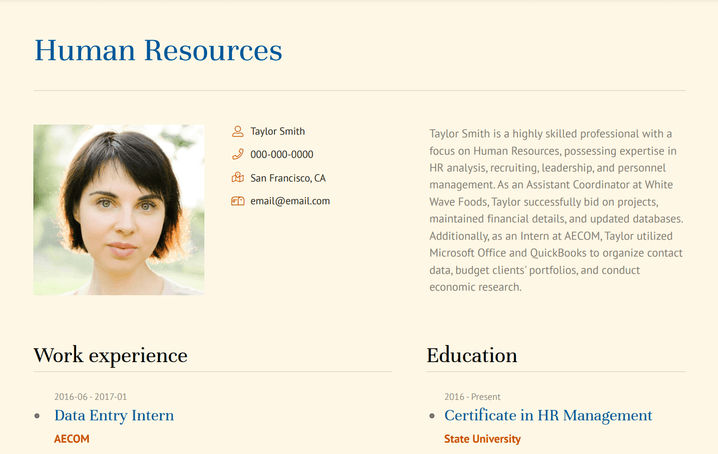
Entry Level HR Resume: How to Write an HR Resume With No Experience
When you want to land an HR job but you have no experience, it’s important to learn how to write a great entry-level HR resume.
Human Resources, often referred to as HR, is a competitive industry, so standing out can be difficult.
Fortunately, hiring managers know that entry-level applicants are not likely to have much work experience. Instead, they will be looking for the transferable skills, technical skills, and education that will help you succeed in HR. In this article, we will show you how to focus on your most impressive and most relevant HR skills.
To write an entry-level HR resume:
- Write an impressive summary
- Highlight your most relevant skills
- Showcase your academic credentials
- Customize your resume for every application
- How to write an Entry Level HR Resume
To write a great entry-level HR resume, it’s important to make sure to use all the right sections. To do this:
1. Write a great HR resume Summary Section
The first step to writing a great HR resume is creating a strong summary. On a resume, a summary is a short paragraph or bulleted list highlighting your most relevant skills or experience. This might include key achievements, important performance metrics, or the tools you have expertise in.
A Summary section is optional on a resume, but an effective summary is the best way to introduce yourself to an employer. When you don’t have much experience in HR, an impressive summary with transferable skills, notable classwork, or impressive accomplishments may be what encourages a hiring manager to keep reading.
No Experience HR Resume Summary Example
Taylor Smith is a highly skilled professional with a focus on Human Resources, possessing expertise in HR analysis, recruiting, leadership, and personnel management. As an Assistant Coordinator at White Wave Foods, Taylor successfully bid on projects, maintained financial details, and updated databases. Additionally, as an Intern at AECOM, Taylor utilized Microsoft Office and QuickBooks to organize contact data, budget clients' portfolios, and conduct economic research. Taylor holds a Certificate in Human Resource Management from State University, showcasing a comprehensive understanding of HR principles and practices. With a commitment to professional development and a strong work ethic, Taylor is well-equipped to tackle HR challenges and propose effective solutions.
2. List your Work Experience
Even if you don’t have much experience, it’s important to include a Work Experience section on your resume. This section is mandatory, and any HR resume with no Work Experience section will be ignored.
If you have held jobs in the past, but they don’t seem relevant to an HR position, you should still add them to your resume. Simply brainstorm any skills or activities that might have prepared you for an HR role and focus on the most relevant aspects of the job. Administrative tasks, people management, and conflict resolution are all things that will be relevant to your future HR career.
If you are a student, there may be student clubs or organizations that you are involved in. If you held a position in a particular group, like treasurer or general secretary, you likely gained experience that will be relevant to an HR role.
Your Work Experience section may be short, as you have no experience, but that’s not a dealbreaker for most entry-level positions. As long as you include the section and show your experience as well as you can, you can make up for your lack of experience in your other sections, like Skills and Education.
HR No Experience Resume Work Experience Example
Human Resources Intern Praxair, Inc
- Assisted the Human Resources Manager in the selection process by conducting thorough background checks and verifying credentials, ensuring the hiring of qualified candidates.
- Collaborated with the HR team to define staff compensation and benefits ranges, ensuring competitive and fair remuneration packages.
- Streamlined the hiring process by implementing an efficient system for background checks and credentials verification, reducing time and effort required for candidate evaluation.
- Maintained accurate and up-to-date records of applicant information, ensuring compliance with company policies and legal requirements.
- Actively participated in team meetings and discussions, providing valuable insights and suggestions for improving HR processes and procedures.
- Demonstrated strong attention to detail and accuracy in all aspects of work, ensuring the integrity and reliability of candidate information and compensation data.
- Communicated effectively with candidates and employees, providing clear and concise information regarding hiring processes, compensation, and benefits.
- Proofread all documentation and reports, ensuring they were error-free and presented a professional image of the HR department.
Data Entry Intern AECOM
- Utilized advanced Microsoft Office skills to efficiently organize contact data, build databases, and design mass marketing mailings, resulting in a 20% improvement in efficiency and accuracy of client communications.
- Demonstrated proficiency in financial management software, including QuickBooks and PC Law, to organize, review, and budget clients' portfolios, ensuring accurate and timely financial reporting.
- Maintained meticulous records and documentation, ensuring the integrity and security of sensitive client information.
- Consistently met deadlines and managed multiple tasks simultaneously, demonstrating strong organizational and time management skills.
- Collaborated effectively with team members, providing support and assistance as needed to ensure the smooth operation of daily tasks and projects.asd
3. Highlight your HR Education
If you don’t have much work experience, your Education section is a great opportunity to showcase some of your HR skills. If you have a Human Resources Management certificate or degree from an accredited post-secondary institution, or even if you have simply taken some HR classes as a part of a different degree, it is important to include them in your resume.
Because you don’t have much work experience, you can give more space to your Education section on your HR resume. Fill out the section with details like relevant classes or coursework, any important projects, or some of the important HR skills you learned in school.
4. List your HR Skills
In an entry-level HR resume, skills are integral. When you don’t have much experience, your skills are what hiring managers will be looking for to see whether you can do the job. This means you should pay special attention to your Skills section, and make it the most impressive part of your resume.
HR skills might include:
- Interviewing
- Change Management
- Microsoft Office
- Strategic Planning
- Team Building
- Organizational Development
To write a simple Skills section, list your skills in order of relevance in a bulleted list. This is the quickest and easiest way to display your skills, and it will work for most resumes. For added detail, some job-seekers will split their Skills section in two: Soft Skills and Technical Skills .
If you want to emphasize your skills further, make each skill its own heading within your Skills section and add bullets below it with examples or explanations of that skill area. This could include highlighting accomplishments, classwork, or experience relevant to that skill.

If you really want to emphasize your skills, you may even want to write a skills-based resume . In a skills-based resume, your Skill section is the largest and most prominent part of the resume, and the Work Experience section can be smaller and less detailed. When done well, this resume format can be very effective for job-seekers who don’t have much experience, as well as people who are changing careers or returning to work after an absence.
5. Include additional HR resume sections
While the sections described above are the most important and will be enough for many job-seekers, you may want to add some additional sections to your entry-level HR resume. Additional HR resume sections might include:
- Volunteering experience
- Certifications
- Interests and activities
- Professional memberships
HR No Experience Resume Memberships Section Example
PROFESSIONAL MEMBERSHIPS
TEAM LEAD, STUDENTS IN FREE ENTERPRISE
- Led a team of dedicated individuals in planning and organizing networking events for regional competitions, ensuring smooth execution and successful outcomes.
- Collaborated with team members to develop event strategies, resulting in increased participation and engagement from stakeholders.
- Implemented efficient event management processes, resulting in improved coordination and timely execution of tasks.
- Collaborated effectively with other board members, fostering a supportive and inclusive environment that facilitated consensus-building and problem-solving.
MEMBER AND AV SPECIALIST, SOCIETY FOR HUMAN RESOURCE MANAGEMENT
- Provided audio/visual support during events, ensuring seamless delivery of presentations and enhancing the overall attendee experience.
- Documented event details and outcomes, facilitating post-event analysis and continuous improvement.
- Entry Level HR Resume with No Experience Examples
Writing a no-experience HR resume might seem impossible, but remember: everyone has no experience at first. You can still get a job with an entry-level HR resume, you just need to make sure to highlight the right skills and experience. Use these entry-level HR resume examples to get inspired:
Entry Level HR Resume Example 1
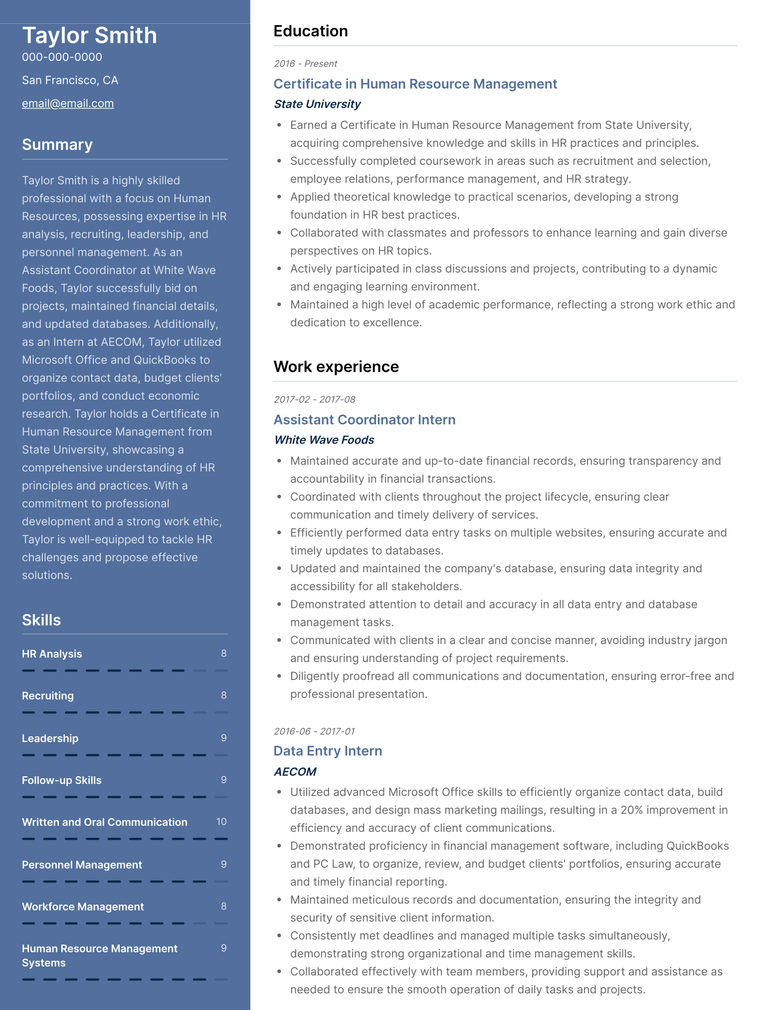
Entry Level HR Resume Example 2
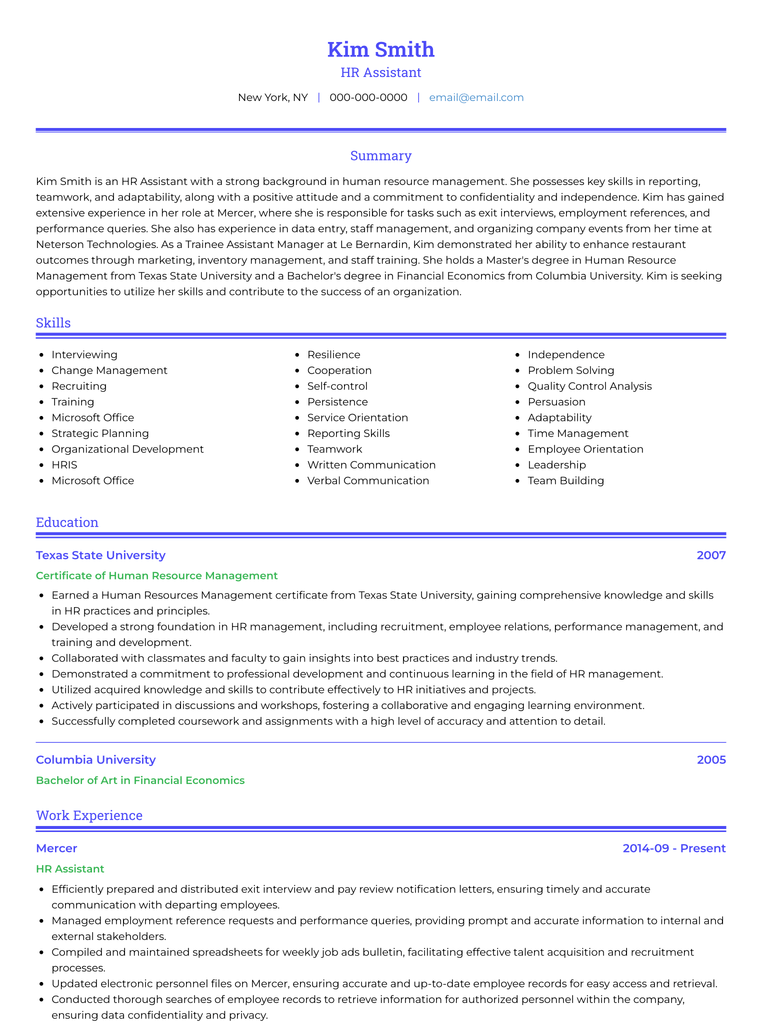
Entry Level HR Resume Example 3
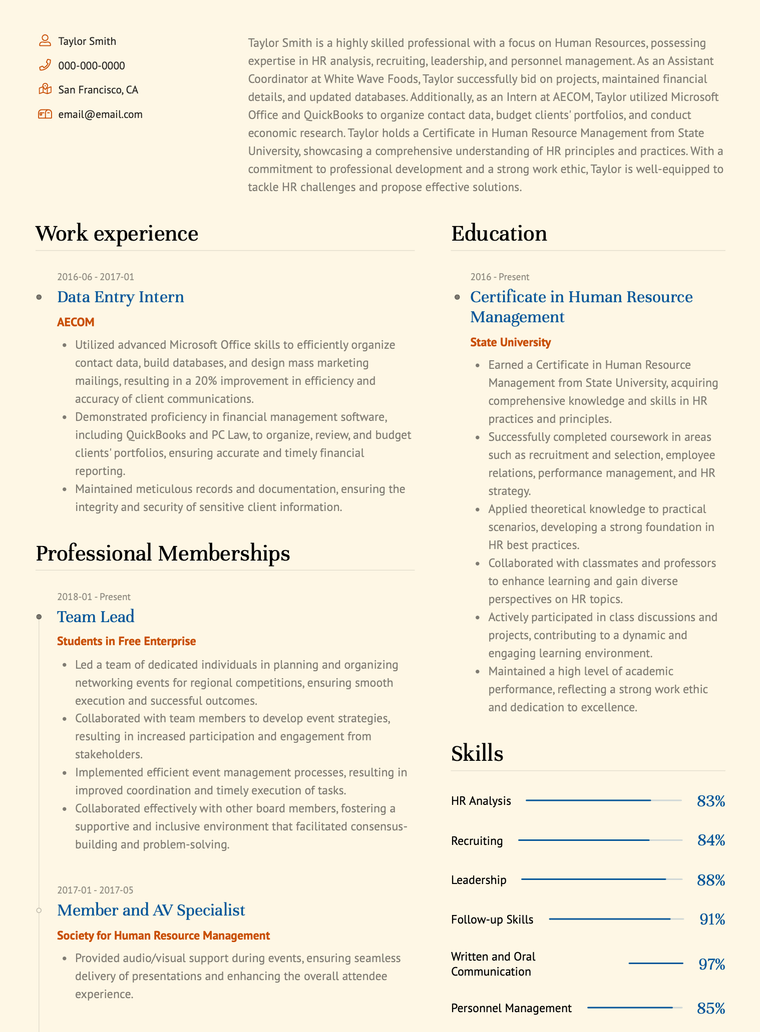
- Entry Level HR Resume FAQs
If you have some lingering questions about writing a no-experience HR resume, these FAQs may answer them:
Summary or Objective for your Entry-level HR Resume with No Experience?
When you write an entry level HR resume, you should use a Summary instead of an Objective. Objective sections were once common, but are now rarely included in resumes and may seem old fashioned.
What is an Example Entry Level HR Resume Summary for 0-1 Year Experience HR Professionals?
An example resume summary for an entry-level HR resume may be:
Taylor Smith is an HR professional with a strong education in recruitment, payroll management, vendor management, change management, employee engagement, and international recruitment. With an MBA in Human Resources Management from Northwestern University, Taylor is equipped with the knowledge and skills to drive HR excellence. With a proven track record in attaining high grades and peer reviews at [school name], Taylor has successfully studied strategies for HR management and development, supported talent management initiatives, and led change management projects.
What is the Right Way to Fill Work History When You have No HR Experience?
If you have never held a job in the HR field, consider any internships or work placements you may have completed during your education. You may need to include unrelated jobs or summer jobs, even if they aren’t directly relevant. If you have no previous positions at all, consider any personal projects, volunteer roles, or activities that might have taught you transferable skills. Anything that seems relevant to HR is a candidate for inclusion in your resume.
For more tips on writing an HR resume when you don’t have experience, check out our article How to Write a Student No Experience Resume .
How Do You Add Keywords to Your Entry-Level HR Resume?
When you are applying for entry-level HR jobs, it’s important to make sure that your resume has the right keywords so it is selected by the Applicant Tracking System (ATS) .
To ensure your HR resume has the right keywords, customize your resume for every application. To do this, study the job posting closely, and take note of the specific skills, tools, technologies, and experience it is asking for. These are likely the keywords that the company is looking for.
Then, use those exact keywords in your resume as you write it. You can’t include any false details, of course, but as long as the keywords genuinely apply to you, include them in your resume where they are relevant. This way, your resume will be a better match for the job posting, and the hiring manager will be more likely to see it.
What are the Best Certifications for an Entry-Level HR Resume?
If you want to enter the Human Resources field, you will likely start by getting an education. There are many institutions that offer HR certifications, including organizations like Human Resources Certification Institute (HRCI), as well as many universities and colleges. Possible HR certifications include:
- Professional in Human Resources
- Certified Compensation Professional
- Human Resource Information Professional
- Certificate in Human Resources Management
- SHRM Senior Certified Professional
- Strategic Human Resources Leadership Certification
- Certified Employee Benefit Specialist
Community Success Manager & CV Writing Expert
Ben is a writer, customer success manager and CV writing expert with over 5 years of experience helping job-seekers create their best careers. He believes in the importance of a great resume summary and the power of coffee.
![how to build experience resume How to write a resume when you have no education [high school or college]](https://www.visualcv.com/static/759484e76e620bca344714a8b70c05bf/61ca5/how-to-write-a-resume-with-no-education.jpg)
You don't need an education to have a great career, and you don't need a degree to write a great resume.
June 27, 2022
If you want to be an optometrist, you need to write a great optometrist CV.
July 21, 2022
![how to build experience resume How to write a copywriter CV [with copywriter cv examples]](https://www.visualcv.com/static/ef6e644f93f2cbeccef86dcca8d5f521/61ca5/how-to-write-a-copywriter-cv-keyboard.jpg)
As a copywriter, your CV has to be a perfect showcase of your writing abilities.
July 13, 2022
Copyright © 2024 Workstory Inc.
Select Your Language:
You are being redirected to the USAJOBS Help Center. Click here if you are not automatically redirected in 5 seconds: https://help.usajobs.gov/how-to .
Your session is about to expire!
Your USAJOBS session will expire due to inactivity in 8 minutes . Any unsaved data will be lost if you allow the session to expire. Click the button below to continue your session.
How to Make a Resume With No Experience in 9 Steps (+ Tips and Best Practices)

Whether you're a new graduate starting your career and creating your first job resume or experienced professional pivoting industries, creating a resume with no experience can seem overwhelming.
But don't get discouraged just yet!
Having a clear idea of how to make a resume with no experience can simplify the process and help you position yourself as a qualified candidate. And with the right approach, you can easily stand out to make a great first impression.
3 key takeaways
- 9 steps for writing your resume with no experience
- Best practices for creating a relevant resume with no experience
- How to use the Teal AI Resume Builder to structure your resume and align your content with any job descriptionThe importance of resume content and structure
A resume is a written record that summarizes your educational and professional background, work experience, skills, and accomplishments.
Compatibility and clarity are the keys to a great resume. The closer your content aligns with a role and the sharper your presentation, the stronger your first impression.
Resume content
Usually, your resume is the first interaction between you, the job seeker, and a prospective employer. And it often determines if they invite you for an interview.
Rather than just a general list of what you've done, your resume is a tool designed to market your abilities, achievements, and potential. Hiring managers have limited time to review every detail on the first pass, and in those moments, they decide whether to dive deeper into your qualifications or move on to the next applicant.
All of that to say, your resume needs to communicate your value proposition quickly, clearly, and effectively. And that's why it should showcase the top 10% of your qualifications that are relevant to the role you're applying for.
Resume structure
While the content of your resume provides insight into your qualifications and achievements, the structure determines how effectively you communicate that content.
While content lays the foundation, the structure elevates it—ensuring hiring managers don't miss the most important parts—the top 10% of your qualifications that align with what they’re looking for.
A well-laid-out structure—formatted clearly, using headings, bullet points, white space, and other design elements, ensures that every critical piece of content, whether it's your educational background, relevant skills, or unique accomplishments, is highlighted and easy to locate.
Pro Tip: Want to showcase your most impressive accomplishments at the top of your resume? Use the Drag-and-Drop Editor within the free Teal AI Resume Builder to arrange each section—ensuring optimal positioning.
Common concerns for first-time resume writers
Understanding common concerns about your content and structure and navigating them with the right strategies can make resume writing less stressful and more effective.
Let's address some of these concerns head-on so you're equipped to present yourself in the best light—regardless of your experience level.
How can I make a resume with no experience?
Creating a resume with no experience can seem challenging, but it's possible!
Before you get started, take some time to consider what you've done throughout your life. Think about:
- Projects you've completed
- Volunteer experiences
- Internships
- Clubs or teams you've been part of
- Awards and scholarships you've received
- Certifications you earned
Then, write down what you accomplished during and as a result of those experiences and how you accomplished it—also known as showcasing impact and skills.
For example, let’s say you just completed your software engineering degree and volunteered at the local Humane Society during your spare time. What are some accomplishments and skills that align with the role of a software engineer?
Animal care: Ensuring 100% of every animal's specific dietary and medical needs are met requires meticulous attention to detail. This aligns with a software engineer's need to write error-free code and ensure every function and API endpoint works as intended.
Clerical and administrative support: Handling animal records using database management software without security breaches or errors can provide a foundational understanding of data organization. This aligns with an engineer's role in data management and integrity. Keeping records organized is also critical, whether managing files, codebases, or server configurations.
What if I don't have anything to put on my resume with experience?
Whether you’re creating your first job resume or are looking to transition from your current career path, your life experience holds more value in a professional setting than you may think.
You have other experiences where you gained considerable knowledge, used valuable skills, sharpened hard skills and soft skills, and owned impressive achievements that carry a lot of weight.
What sections should I include in my resume with no experience?
Every section of your resume is important in highlighting your relevant experience and expertise.
While each of them depends on situation, circumstance, and, most of all, relevance, here are the sections that can help you align your background with a job:
- Contact Information
- Target Title
- Professional Summary
- Skills (hard skills and programs)
- Certifications
- Awards and Scholarships
- Volunteering and Leadership
- Publications
- Interests and Hobbies
You can find the guidelines for each section in these resume best practices .
The information below will focus on the nuances of creating “Professional Summary,” “Education,” “Skills,” “Projects,” “Awards and Scholarships,” “Certifications,” “Volunteering and Leadership,” and “Interests and Hobbies” resume sections with no work experience.
Step-by-step guide: Crafting a resume with no experience
Step 1: Understand how to emphasize relevant soft and hard skills
While your “Skills” section won’t be the first section of your resume, before you begin drafting your content, it’s important to understand that your hard and soft skills should be incorporated throughout each section.
Instead of just including a bullet-point list of words, highlight key skills that align with the job description of the position you're applying for throughout and emphasize how you've used these skills for meaningful impact.
For example, rather than listing “communication skills” and “data analysis” in a dedicated “Skills” section, incorporate them into your professional summary like this:
Leveraging communication skills and data analysis, I spearheaded a group presentation in Economics 405, achieving a 95%.
Step 2: Write a strong professional resume summary
Just because you're creating a resume with no work experience doesn't mean you can't take advantage of a resume summary.
Especially when you want to highlight the value of what you have to offer and how it relates to the job you're seeking, creating a concise description of why you're the optimal candidate for the job will allow you to stand out and grab attention.
Rather than using an outdated resume objective, a modern professional summary should:
- Be tailored to the job you're applying to using keywords from the job description
- Incorporate at least two relevant skills and their corresponding impact
- Be between 3-5 sentences
- Use the first-person voice
These resume examples of professional summaries demonstrate how it's done.
As a highly motivated student, I have valuable experience in leadership. As Vice President of the student council, I launched 5 school-wide fundraisers and drove a 25% increase in student engagement. As soccer team captain, I leveraged leadership, communication, and teamwork skills to guide us to an 85% win rate. My tutoring efforts supported 30+ peers, elevating their academic performance. Balancing a demanding schedule, I maintained a 3.7/4.0 GPA.
As an outbound sales representative, I exceeded quarterly targets QoQ by 15%, driving significant revenue growth. Now, I'm enthusiastic about pivoting to marketing. My strength in communication resulted in building lasting relationships, with a 79% retention rate of high-value clients. My aptitude in lead generation helped cultivate a pipeline that boosted sales conversion by 20%. Leveraging these skills and insights into client needs, I believe I can craft impactful marketing campaigns and strategies.
For more insights and examples on writing a beginner's resume summary, check out this beginner resume summary guide .
Step 3: Highlight educational achievements
If you’re still in school or a recent graduate, offering a detailed look at your education can help you align your skills, their impact, and your relevant experience with the role you’re applying for.
Your basic education should look something like this:
- Degree or diploma earned
- Institutions name
- Completed date or anticipated graduation date
- GPA if above 3.0
Then, beneath that information, incorporate relevant academic achievements—courses and relevant coursework like research papers, assignments, and presentations. (You can also include relevant projects and activities, or you can create dedicated “Projects and “Activities” sections—more on that below.)
Continue to incorporate hard and soft skills throughout your achievements using keywords from the job description that will align your content with the position.
Let’s say you want to apply for a role as a marketing generalist, but you don’t have relevant work experience. The job description includes the following details:
- Plan and execute direct outreach marketing campaigns, including utilizing lists from conferences and follow-up from prior conversations with prospects
- Coordinate and oversee all conference logistics and planning
- Manage and post content on various social media platforms
- Collaborate with internal teams to ensure alignment with brand messaging and goals
A comprehensive “Education” section that showcases other relevant coursework and relevant experience in a resume for a first job could look something like this:

Step 4: Consider a dedicated “Skills” section
If you can't incorporate your relevant technical skills into every section of your resume, consider adding a dedicated "Skills" section to highlight the hard skills mentioned in the job description (as long as space allows).
Hard skills refer to your practical abilities. These skills are typically concrete and measurable. And you can acquire them through education, training, certifications, or on-the-job experience.
Hard skills include things like Adobe XD, Google Suite, data analysis, coding languages, SEO copywriting, Microsoft Excel, and more.
While you can include soft (or transferable) skills in this dedicated section, keep in mind these are more challenging to measure objectively, and you should demonstrate them alongside complementary hard skills and impact.
Pro Tip: Want to make sure you've got the right skills for every application? Use Matching Mode in Teal's free AI Resume Builder to quickly compare the skills and keywords in a job posting to those in your resume. Then, receive a "Match Score."
You want your Match Score to be as close to 80% as possible. You can incorporate more skills and other keywords from a job listing into your content to improve your score—creating a tailored resume.

Try Teal's Matching Mode today .
Step 5: Add relevant certifications
Certifications help align your credentials to the qualifications prospective employers are looking for.
As a student, adding certifications to your resume shows potential employers you have practical, up-to-date expertise beyond theoretical learning.
As a career pivoter, you can use certifications to align your skills and experience with the qualifications employers in your target industry seek. Obtaining recognized and valued certifications within your desired field showcases your commitment to learning and adapting to new challenges.
Step 6: Leverage projects and their results
Projects contribute to professional growth through the lessons or skills you’ve learned. The key to including team, personal projects, and academic or school projects in your resume with no experience is selecting ones relevant to the job ad or industry you're targeting.
Choosing the right projects will help your application resonate with the hiring manager, showcasing your expertise in a way that directly relates to the position you're applying for.
If you're pivoting careers, consider the projects you completed in your last role. What soft or transferable skills did you use to achieve the final result? The projects that incorporate the skills highlighted by a recruiter or hiring manager are the ones you should include on your resume.
Use the same resume format you would for a comprehensive "Work Experience" section. Your "Projects" section should include:
- Name of the project
- The organization you were with while completing that project
- Dates started and completed
- The scope (for example, the size of the team, project duration, or budget)
- Any feedback received
- Measurable results
Using the same information for the marketing generalist role above, this is what a relevant project looks like for a college student with no job experience:

And this is what a relevant project looks like for a job seeker pivoting careers from an administrative role to marketing:

Step 7: Include volunteer experience
Volunteering or leadership experience reveals your character, motivation, and values.
And just like you emphasize skills in your "Education" and "Projects" sections, integrating keywords from the job description into your volunteer work experiences will align them with the job you're pursuing.
To showcase relevant volunteer experience on your resume, include:
- The organization
- Your involvement or role
- City and State
- Dates of experience
- Your quantified (using numbers, metrics, and data) achievements
Step 8: Showcase awards and scholarships
Awards and scholarships often require specific skills—aptitudes like technical knowledge, leadership, teamwork, or creativity.
For instance, a "Most Innovative Project" award would signal creativity and problem-solving skills. A Scholarship for "Excellence in Community Service" acknowledges dedication to giving back and underscores the ability to collaborate effectively.
Here's how to list an award or scholarship on your resume:
- Name of the award or scholarship
- Organization
- Date Step 9: Consider adding interests and hobbies
If you still feel your resume is light on content, consider adding a section for interests and hobbies if (and only if) they’re relevant to the job.
Hobbies and extracurricular activities can be remarkably relevant to specific roles. For example, a hobby like Debate Club could align with skills needed in marketing or sales that require strong communication, articulation, and persuasion. A hobby such as ethical hacking indicates programming skills, problem-solving abilities, and a passion for technology—often necessary in software, data, and IT.
Best practices for how to make a resume with no experience
Tailor your resume for each job application.
Every job is unique, and so your resume should be, too. By tailoring your resume , your relevant experiences will better align with the hiring manager's requirements and qualifications.
Quantify achievements whenever possible
Using numbers, metrics, and data to showcase impact offers prospective employers tangible proof of your accomplishments.
Optimize professional presentation
Consistent formatting (in terms of fonts, bullets, white space, and headings) gives your resume a professional look. In addition, make sure to double-check spelling, punctuation, and grammar to maintain a polished and error-free document.
Pro Tip: If you want to understand more about formatting, including a deeper look at a chronological format and a functional resume format, check out this guide to the best resume formats .)
Write your resume today—no work experience required
Your unique experiences, skills, and professional achievements, even outside of traditional work settings, can significantly position you as a strong candidate.
By following the steps above and focusing on relevant experiences, creating a resume with no experience becomes a powerful showcase of your potential.
Let the free Teal AI Resume Builder help you streamline the process with its suite of tools. From the Drag-and-Drop Editor and Matching Mode to ready-made templates that ensure your resume is professional for every application, sign up for Teal today and begin your journey with confidence.
Frequently Asked Questions
How can i make my resume stand out if i don't have any formal work experience, what should i include in the education section of my resume if i have no experience, how do i address the lack of experience in a resume cover letter.

Kayte Grady
Related articles.

How To Shorten Your Resume (Tips, Tools, & Examples)

157 Computer Skills For Your Resume (+ How to List Them)

11 Signs Your Resume is Outdated (+ How To Fix It)

How to Write Areas of Expertise on a Resume (+ Examples)

We help you find the career dream.

IMAGES
VIDEO
COMMENTS
See Which Resumes Employers Loved in 2019 and Build the Perfect Resume in 2020. Create the Perfect Job-Worthy Resume to Attract More Attention. Get Started Now!
Average Completion Time: 15 minutes. Over 35,761 Resumes Created Today! Get started. The #1 Recommended Resume Builder. Build Your Perfect Resume With Our AI Guided Steps!
Learn how to format, describe and tailor your work experience section to impress hiring managers. See examples of effective bullet points, action verbs and quantifiable achievements for different jobs.
Learn how to make a resume for your desired job with 9-step instructions and 10 resume examples. Find out how to choose the right resume format, highlight your skills, and avoid common mistakes.
Here's an example of how to list achievements on a resume: "Supervised 15 new hires and trained them in upselling techniques, which resulted in 23% increase of credit card applications at check out.". Notice how this work experience description begins with an action verb.
5. Don't Forget Your Education. If you're still in school or just graduated, your education can go at the top of your resume, but for pretty much everyone else, this goes near the bottom. Most people include their school, graduation year (for folks less up to about a decade out of school), major, and degree.
Key Takeaways. Be brief when listing your work experience. Put the accurate title, company name, employment start and end dates (a month and a year). Make the work experience part a separate section, but use the same formatting rules as in the rest of the resume.
Over 30+ resume template options to help you create a resume that will get you the job. Resume Samples. Find the perfect free resume sample and upgrade your resume with VisualCV. ... customer success manager and CV writing expert with over 5 years of experience helping job-seekers create their best careers. He believes in the importance of a ...
The work experience section of your resume provides employers with an overview of all jobs you've held in the past. Whether you're brand new to the workforce or making a career change, it is the first thing you need prepared and ready to go. ... Try our Resume Builder today! Check out other helpful resume-writing tips here: Picture Perfect ...
800+ Resume Examples and Guide for 2024. By Kellie Hanna, CPRW, Career Advice Expert Last Updated: February 22, 2024. Browse top resume examples by job, industry, format, and experience level. Our team of Certified Professional Resume Writers (CPRW) creates and approves every sample. Import existing resume Build my resume.
A good resume needs to show that you already have the skills needed to be successful in a target job. A resume needs a lot of planning, regular input from experts and flexibility on your part. The most important step to building a strong resume is to start early. We explain how to successfully build resumes at various stages of your career.
Use an easy-to-scan template. Here's how a typical hiring manager and recruiter will read your resume: 1. Quick scan. They'll do a short scan of a few seconds, gathering all key information. Your location, years of experience, languages and technologies, position names, company names, and anything else that stands out.
Step 1: Start with the Right CV Format. Recruiters spend only 6-7 seconds scanning each CV. So, the very first impression is key. If you submit a neat, properly organized document, you'll convince the recruiters to spend more time on your CV. Here's how to make a CV format the right way.
Resume Templates by experience. Whether you're an entry-level worker with no experience, a C-Level Exec, or it's your first time creating a resume, the following free resume templates will help you get started. Just click on the one that best will suits your needs, replace the content with your skills and achievements, and hit download.
How to Build Experience. Building experience is an important part of the college experience and essential to preparing for next steps. This guide walks through the variety of different types of experience and how they can be beneficial. View Resource.
How to supply work experience. In this section you'll enter your relevant work experiences. If your resume is confidential, any work experience with an end date of 'present' will not be visible to Federal recruiters performing resume searches. To complete this section, enter information and click 'add work experience.
Entry-Level ATS-Friendly Resume Templates. You might not think you have a lot to show on your resume, but you do! These templates provide sections where you can highlight your education, internships, volunteer experience, personal accomplishments, and more.. An ATS-friendly resume will help you get found by recruiters and hiring managers. This is important because an entry-level position could ...
Examples of introduction when emailing a resume: "My name is Roger Jones. I'm writing this email to express my interest in the job vacancy at Valcor". "My name is Roger Jones, and I am submitting my application for the current job opening as Financial Analyst at Valcor.". "My name is Roger Jones. I came across Valcor's job ads on ...
Work experience (which will be substituted with other sections when you have no work experience) Education. 2. Incorporate your contact information. Now that you've chosen the best format for a resume with no experience, it's time to complete each section. The first section of your resume is the header section.
Example: "Achieved goal of reaching 250% annual sales quota, winning sales MVP two quarters in a row.". Be brief. Employers have mere seconds to review your resume, so you should keep your descriptions as concise and relevant as possible. Try removing filler words like "and," and "the.".
Writing a Resume With No Experience. Start with a professional summary. Emphasize your education. Include relevant experience like internships and extracurriculars. Highlight your accomplishments. Showcase your skills. Don't include a headshot, hobbies and other unnecessary details.
To write a great entry-level HR resume, it's important to make sure to use all the right sections. To do this: 1. Write a great HR resume Summary Section. The first step to writing a great HR resume is creating a strong summary. On a resume, a summary is a short paragraph or bulleted list highlighting your most relevant skills or experience.
How to supply work experience. In this section you'll enter your relevant work experiences. If your resume is confidential, any work experience with an end date of 'present' will not be visible to Federal recruiters performing resume searches. To complete this section, enter information and click 'add work experience.
Learn how to create a professional resume format for experienced job applicants with a sample and tips. Find out the best resume format, layout, fonts, and skills to highlight your career achievements.
Step 3: Highlight educational achievements. If you're still in school or a recent graduate, offering a detailed look at your education can help you align your skills, their impact, and your relevant experience with the role you're applying for. Your basic education should look something like this:
Respectfully, Kind regards, Best regards, Yours truly, Then, make two spaces below the salutation, and type your full name. For some professional (but optional) flair, sign your cover letter either with a scan of your signature or by using software like DocuSign. 8. Check your cover letter's content and formatting.